Search Result
Results for "
cell-cell
" in MedChemExpress (MCE) Product Catalog:
87
Isotope-Labeled Compounds
| Cat. No. |
Product Name |
Target |
Research Areas |
Chemical Structure |
-
- HY-115399A
-
|
3-Oxo-C16-AHL
|
Bacterial
|
Metabolic Disease
|
|
N-3-Oxo-hexadecanoyl-L-Homoserine lactone is a signaling molecule to coordinate group behaviors at high densities in many bacteria. N-3-Oxo-hexadecanoyl-L-Homoserine lactone adsorbs to and promotes the remodeling of lipid membranes in ways that could underpin cell-cell or host-cell interactions .
|
-

-
- HY-114041
-
|
RvE1
|
Endogenous Metabolite
|
Inflammation/Immunology
|
|
Resolvin E1 (RvE1), a potent endogenous pro-resolving mediator of inflammation, is derived from omega-3 fatty acid eicosapentaenoic acid (EPA). Resolvin E1 is endogenously biosynthesized from EPA in the presence of Aspirin during the spontaneous resolution phase of acute inflammation, where specific cell-cell interactions occur. Resolvin E1 possesses unique counterregulatory actions that inhibit polymorphonuclear leukocyte (PMN) transendothelial migration. Resolvin E1 also acts as a potent inhibitor of leukocyte infiltration, dendritic cell migration, and IL-12 production .
|
-
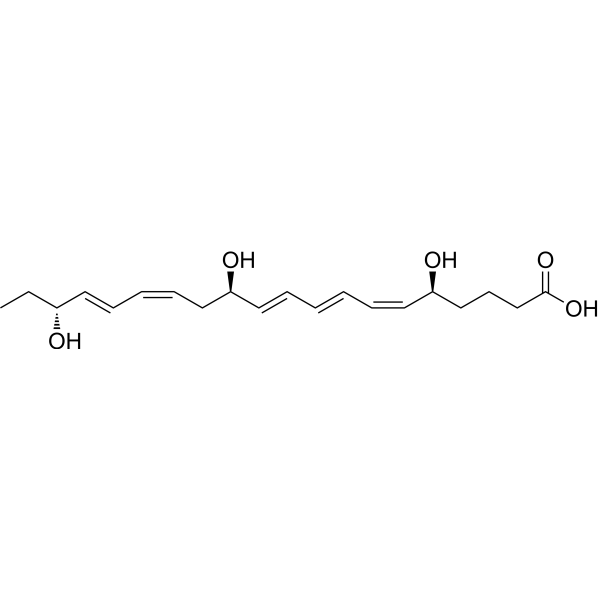
-
- HY-100355
-
|
|
Endogenous Metabolite
|
Neurological Disease
Cancer
|
|
C18-Ceramide can promote exocytosis of glutamate from damaged neurons. C18-Ceramide promotes cell death in glioma cells. Ceramides is involved in diverse cellular functions, such as differentiation, cell cycle progression, cell-cell adhesion, senescence, and apoptosis .
|
-

-
- HY-N10534
-
|
Lewis X
|
Parasite
|
Infection
Inflammation/Immunology
Cancer
|
|
Lewis X trisaccharide (Lewis X, Le x) is a potent TH2 regulator, antagonizes LPS-induced IL-12 immune expression. Lewis X trisaccharide is a human histo-blood group antigen, plays an key role in cell-cell adhesion, and servers as a tumor marker. Lewis X trisaccharide is highly expressed in the outer membrane of the parasite, can be used for the immunology research of schistosomiasis .
|
-

-
- HY-D1672
-
|
|
Fluorescent Dye
|
Neurological Disease
|
|
TMR Biocytin is a polar tracer used in the research of cell-cell and cell-liposome fusions, as well as membrane permeability and cellular uptake during pinocytosis. TMR Biocytin can be detected using streptavidin, and is an effective neuronal tracer in live tissue (Ex=544 nm, Em=571 nm) .
|
-
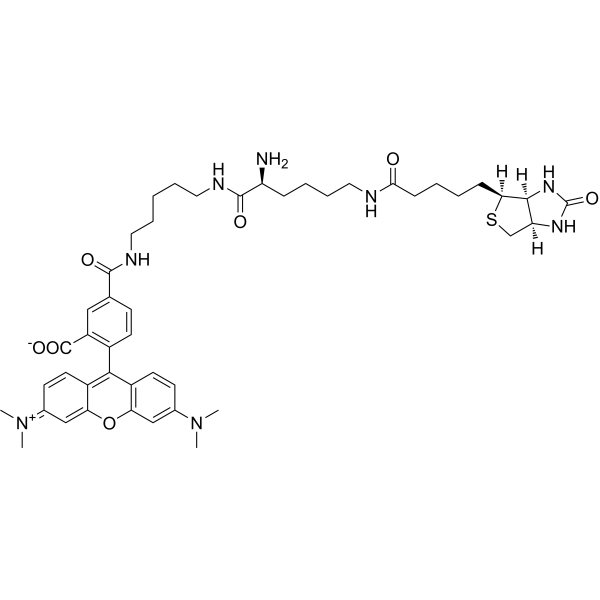
-
- HY-161424
-
|
|
Others
|
Cancer
|
|
ZJ-101 is a structurally simplified analog derived from the marine natural product superstolide A. ZJ-101 exhibits potent antiproliferative activity. ZJ-101 can target and inhibit O-glycosylation, thereby modulating the endomembrane system. ZJ-101 can inhibit cell-cell adhesion .
|
-

-
- HY-126666
-
|
|
ADC Cytotoxin
|
Inflammation/Immunology
Cancer
|
|
PNU-159682 carboxylic acid (compound 53) is a potent ADCs cytotoxin and encodes a member of the C-type lectin/C-type lectin-like domain (CTL/CTLD) superfamily. PNU-159682 carboxylic acid has protein fold and diverse functions, such as cell adhesion, cell-cell signalling, glycoprotein turnover, and roles in inflammation and immune response .
|
-
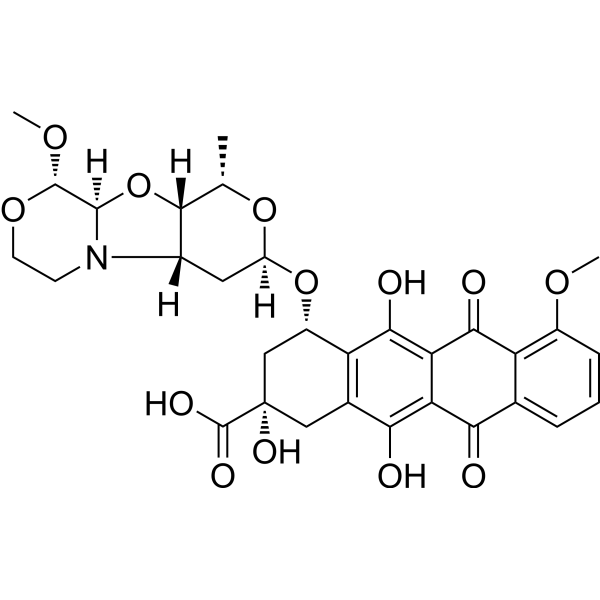
-
- HY-W007511
-
|
Isohexanol
|
Others
|
Neurological Disease
|
|
4-Methyl-1-pentanol (Isohexanol) is a pentanol added with methyl group, which can be used as a solvent and has excellent synergistic effect with PVCap. 4-Methyl-1-pentanol is also a volatile aroma component of red wine, which is often used in the production and blending of wine. 4-Methyl-1-pentanol can also be used as an alcohol antagonist to antagonize the effects of ethanol and 1-butanol on L1-mediated cell-cell adhesion, and is used in the study of fetal alcohol syndrome .
|
-
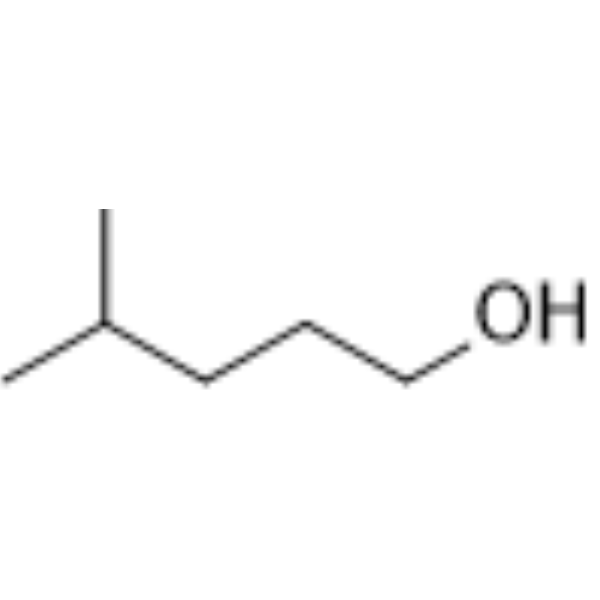
-
- HY-123453
-
|
NSC 37204
|
FGFR
|
Cancer
|
|
SM27 (NSC 37204) is an inhibitor for fibroblast growth factors (FGF). SM27 inhibits angiogenesis through block of FGF2/HSPGs/FGFR1 complex formation .
|
-
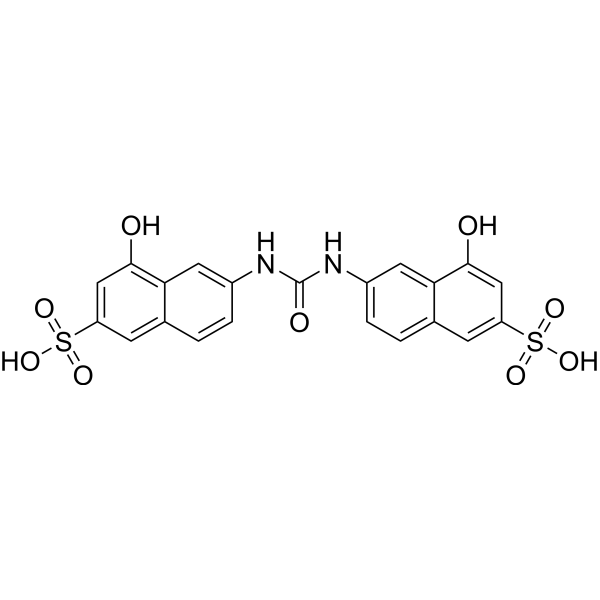
-
- HY-114041S1
-
|
RvE1-d4-1
|
Endogenous Metabolite
|
Inflammation/Immunology
|
|
Resolvin E1-d4-1 is the deuterium labeled Resolvin E1. Resolvin E1 (RvE1), a potent endogenous pro-resolving mediator of inflammation, is derived from omega-3 fatty acid eicosapentaenoic acid (EPA). Resolvin E1 is endogenously biosynthesized from EPA in the presence of Aspirin during the spontaneous resolution phase of acute inflammation, where specific cell-cell interactions occur. Resolvin E1 possesses unique counterregulatory actions that inhibit polymorphonuclear leukocyte (PMN) transendothelial migration. Resolvin E1 also acts as a potent inhibitor of leukocyte infiltration, dendritic cell migration, and IL-12 production[1][2].
|
-

-
- HY-B0497BS
-
|
BAY2353-13C6 monohydrate
|
STAT
Parasite
Antibiotic
|
|
|
Niclosamide- 13C6 (monohydrate) is the 13C labeled Niclosamide monohydrate[1]. Niclosamide (BAY2353) monohydrate is an orally active antihelminthic agent used in parasitic infection research[2]. Niclosamide monohydrate is a STAT3 inhibitor with an IC50 of 0.25 μM in HeLa cells[5]. Niclosamide monohydrate has biological activities against cancer, and inhibits DNA replication in Vero E6 cells[3][4][6].
|
-

-
- HY-70002S1
-
|
MDV3100-d6
|
Androgen Receptor
|
Cancer
|
|
Enzalutamide-d6 is a deuterium labeled Enzalutamide (MDV3100). Enzalutamide is an androgen receptor (AR) antagonist with an IC50 of 36 nM in LNCaP prostate cells[1].
|
-

-
- HY-B0312S
-
|
|
Phosphodiesterase (PDE)
|
Cardiovascular Disease
|
|
Dipyridamole-d20 is the deuterium labeled Dipyridamole. Dipyridamole is a phosphodiesterase inhibitor that blocks uptake and metabolism of adenosine by erythrocytes and vascular endothelial cells[1][2][3].
|
-
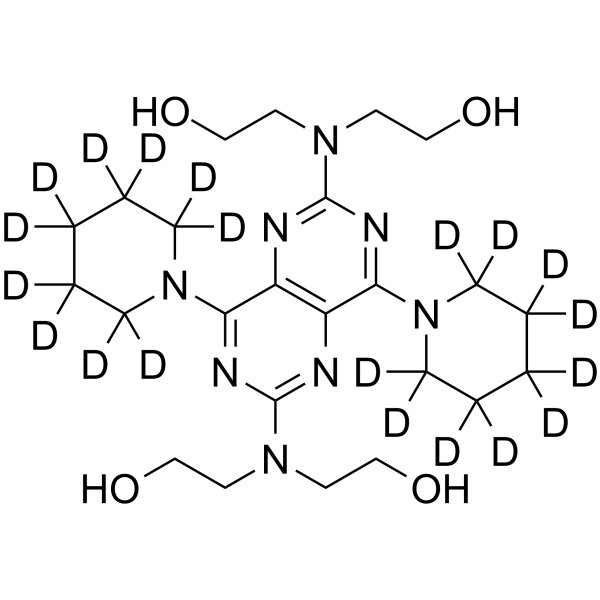
-
- HY-50895S
-
|
ZD1839-d8
|
EGFR
Autophagy
|
Cancer
|
|
Gefitinib-d8 is a deuterium labeled Gefitinib. Gefitinib is an EGFR tyrosine kinase inhibitor, with IC50 of 2-37 nM in NR6wtEGFR cells[1][2].
|
-
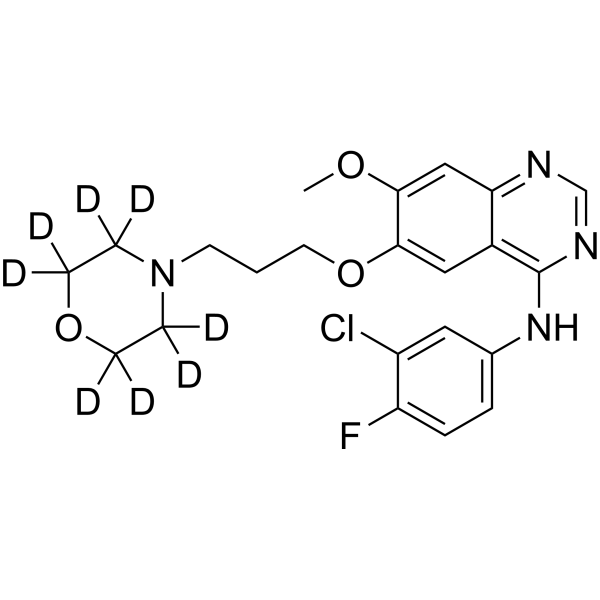
-
- HY-N8015S
-
|
|
Bacterial
Endogenous Metabolite
|
|
|
Octanal-d16 is the deuterium labeled Octanal[1]. Octanal is an aromatic aldehyde, with antioxidant and antimicrobial activities. Octanal shows cytotoxicity against Hela cells[2].
|
-
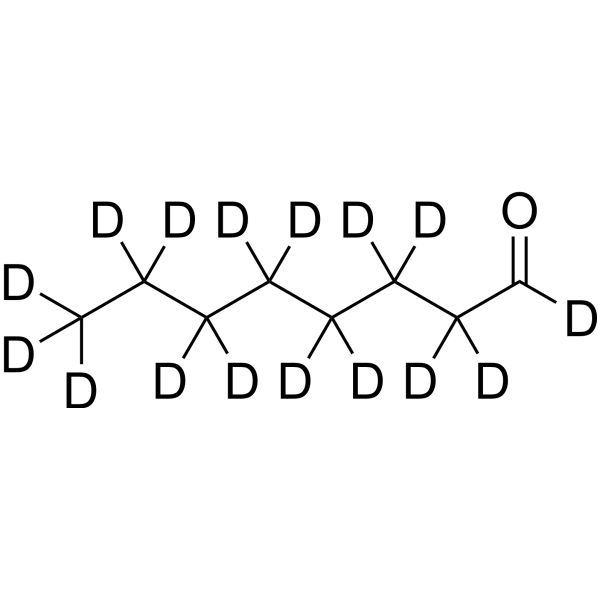
-
- HY-B1878S
-
|
|
Fungal
|
Infection
|
|
Faltan-d4 is the deuterium labeled Faltan[1]. Faltan is a dicarboximide fungicide, widely used on vines and several vegetable crops, and is also cytotoxic effect on human bronchial epithelial cells[2].
|
-
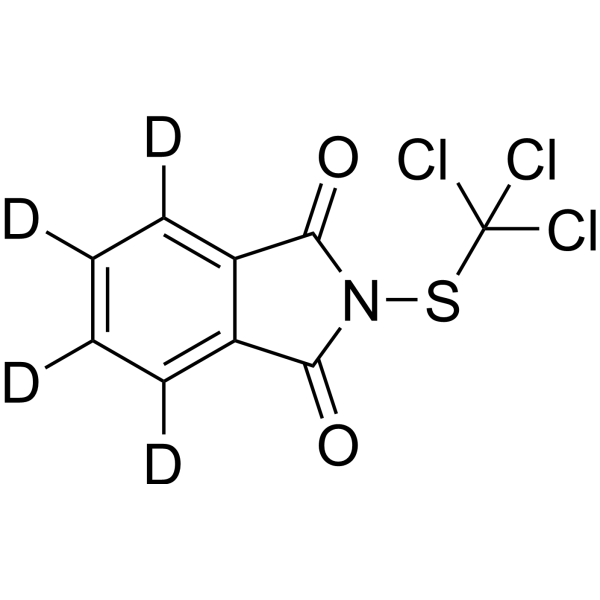
-
- HY-N10350
-
|
|
Others
|
Cancer
|
|
2,3-Dihydro-3-methoxywithaferin A is an analogue of 2,3-dihydrowithaferin-A. 2,3-Dihydro-3-methoxywithaferin A inhibits proiiferation of P388 cells[1].
|
-
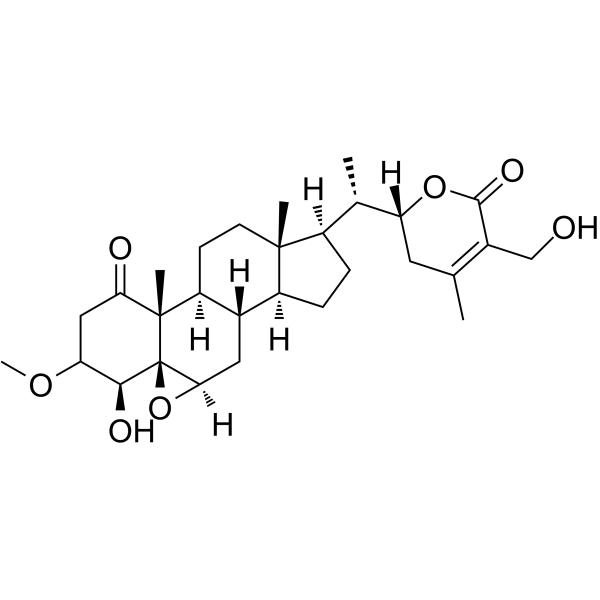
-
- HY-W134007S1
-
-
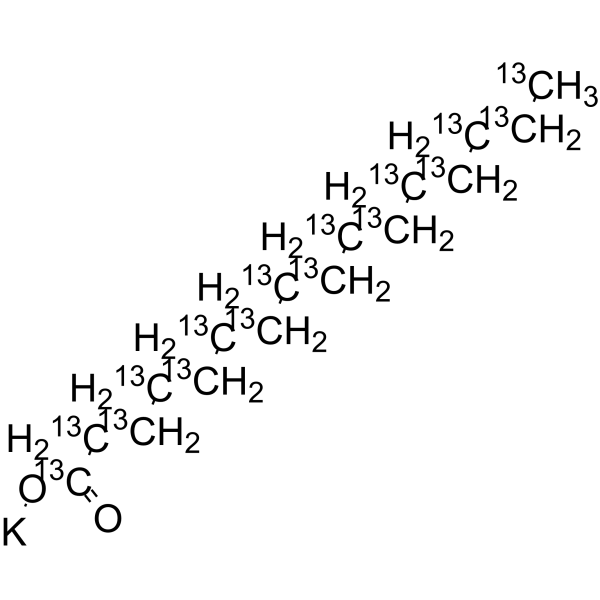
-
- HY-19542S
-
|
|
Isotope-Labeled Compounds
Apoptosis
|
Cancer
|
|
Ceramide C6-d7 is the deuterium labeled Ceramide C6. Ceramide C6, a Ceramide pathway activator, is an exogenous short-chain ceramide which can induce apoptosis of multiple cancer cells[1][2][3].
|
-
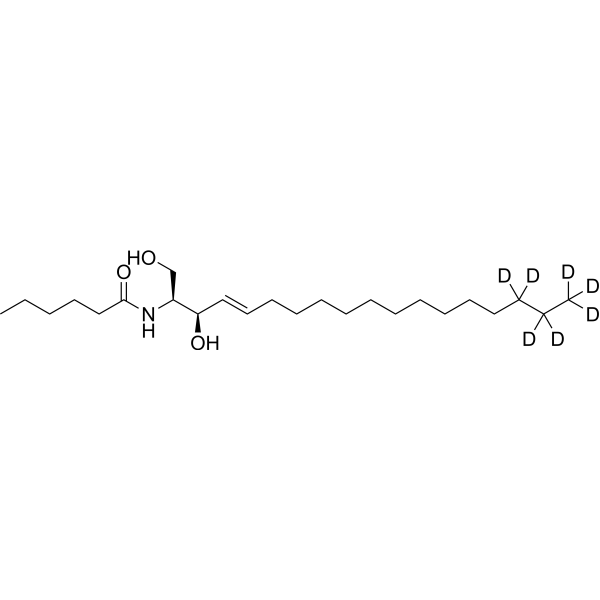
-
- HY-135336AS
-
|
(S)-(-)-Verapamil-d7 hydrochloride
|
Isotope-Labeled Compounds
Leukotriene Receptor
Calcium Channel
Apoptosis
|
Cancer
|
|
(S)-Verapamil-d7 (hydrochloride) is a deuterium labeled (S)-Verapamil hydrochloride. (S)-Verapamil hydrochloride (S(-)-Verapamil hydrochloride) inhibits leukotriene C4 (LTC4) and calcein transport by MRP1. (S)-Verapamil hydrochloride leads to the death of potentially resistant tumor cells[1][2].
|
-

-
- HY-15398S
-
|
|
VD/VDR
Endogenous Metabolite
|
Metabolic Disease
Cancer
|
|
Vitamin D3-d7 is the deuterium labeled Vitamin D3. Vitamin D3 (Cholecalciferol) is a naturally occuring form of vitamin D. Vitamin D3 induces cell differentiation and prevents proliferation of cancer cells[1][2].
|
-
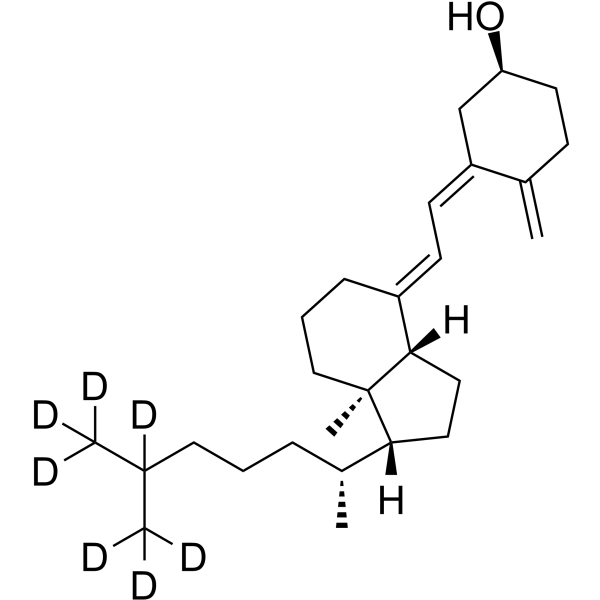
-
- HY-B0234S1
-
|
E1-d2; Oestrone-d2
|
Estrogen Receptor/ERR
Endogenous Metabolite
|
Endocrinology
Cancer
|
|
Estrone-d2 is the deuterium labeled Estrone. Estrone (E1) is a natural estrogenic hormone. Estrone is the main representative of the endogenous estrogens and is produced by several tissues, especially adipose tissue. Estrone is the result of the process of aromatization of androstenedione that occurs in fat cells[1][2].
|
-

-
- HY-B0234S2
-
|
E1-d4; Oestrone-d4
|
Estrogen Receptor/ERR
Endogenous Metabolite
|
Endocrinology
Cancer
|
|
Estrone-d4 is the deuterium labeled Estrone. Estrone (E1) is a natural estrogenic hormone. Estrone is the main representative of the endogenous estrogens and is produced by several tissues, especially adipose tissue. Estrone is the result of the process of aromatization of androstenedione that occurs in fat cells[1][2].
|
-

-
- HY-B2054S
-
|
|
Apoptosis
|
Others
|
|
Tebufenozide-d9 is the deuterium labeled Tebufenozide[1]. Tebufenozide is a nonsteroidal ecdysone agonist used to control pest. Tebufenozide has cytotoxic and induces apoptosis in HeLa and insect Tn5B1-4 cells[2][3].
|
-

-
- HY-B0234S4
-
|
E1-d2-1; Oestrone-d2-1
|
Isotope-Labeled Compounds
Estrogen Receptor/ERR
Endogenous Metabolite
|
|
|
Estrone-d2-1 is the deuterium labeled Estrone. Estrone (E1) is a natural estrogenic hormone. Estrone is the main representative of the endogenous estrogens and is produced by several tissues, especially adipose tissue. Estrone is the result of the process of aromatization of androstenedione that occurs in fat cells[1][2].
|
-

-
- HY-15398S4
-
|
Cholecalciferol-13C5; Colecalciferol-13C5
|
Bacterial
VD/VDR
|
Infection
Endocrinology
|
|
Vitamin D3- 13C5 is the deuterium labeled Vitamin D3 (HY-15398). Vitamin D3 (Cholecalciferol) is a naturally occuring form of vitamin D. Vitamin D3 induces cell differentiation and prevents proliferation of cancer cells[1][2].
|
-

-
- HY-B0234S
-
|
E1-13C3; Oestrone-13C3
|
Estrogen Receptor/ERR
Endogenous Metabolite
|
Endocrinology
Cancer
|
|
Estrone- 13C3 is the 13C-labeled Estrone. Estrone (E1) is a natural estrogenic hormone. Estrone is the main representative of the endogenous estrogens and is produced by several tissues, especially adipose tissue. Estrone is the result of the process of aromatization of androstenedione that occurs in fat cells[1][2].
|
-

-
- HY-B0234S3
-
|
E1-13C2; Oestrone-13C2
|
Isotope-Labeled Compounds
Estrogen Receptor/ERR
Endogenous Metabolite
|
Endocrinology
Cancer
|
|
Estrone- 13C2 is the 13C-labeled Estrone. Estrone (E1) is a natural estrogenic hormone. Estrone is the main representative of the endogenous estrogens and is produced by several tissues, especially adipose tissue. Estrone is the result of the process of aromatization of androstenedione that occurs in fat cells[1][2].
|
-

-
- HY-N7710
-
|
|
Others
|
Metabolic Disease
|
|
FF-MAS is a potent meiotic maturation agonist. FF-MAS promotes meiotic maturation and preimplantation development of mouse oocytes maturing in vitro. FF-MAS promotes the completion of meiotic maturation to metaphase II (MII) and improves competence to complete the 2-cell stage to blastocyst transition .
|
-

-
- HY-133523
-
|
|
Fluorescent Dye
|
Cancer
|
|
HBC514 is a nonfluorescent HBC-analog but emits strong green fluorescence upon forming a tight complex with Pepper RNA aptamer. HBC514-Pepper complex enables visualization of RNAs and the fluorescences can be altered flexibly by simple washing and staining in living Pepper-tagged cells[1].
|
-
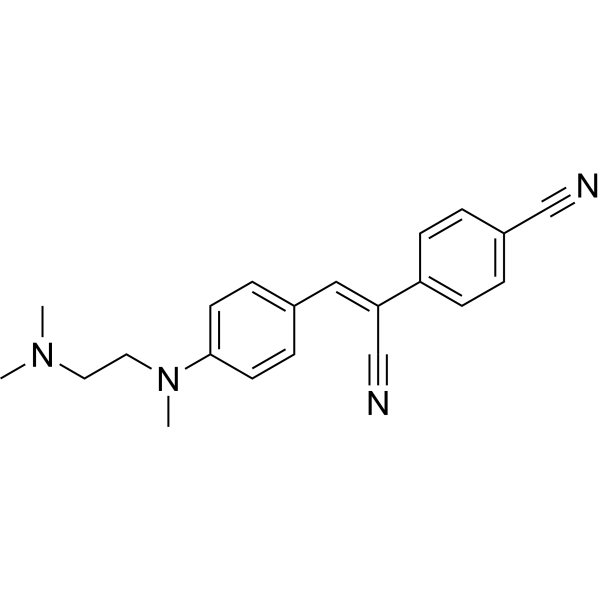
-
- HY-N0390S2
-
|
L-Glutamic acid 5-amide-d5
|
mGluR
Endogenous Metabolite
Ferroptosis
|
Metabolic Disease
|
|
L-Glutamine-d5 is the deuterium labeled L-Glutamine. L-Glutamine (L-Glutamic acid 5-amide) is a non-essential amino acid present abundantly throughout the body and involved in many metabolic processes. L-Glutamine provides a source of carbons for oxidation in some cells[1][2].
|
-

-
- HY-N0390S
-
|
L-Glutamic acid 5-amide-15N
|
mGluR
Endogenous Metabolite
Ferroptosis
|
Metabolic Disease
|
|
L-Glutamine- 15N is the 15N-labeled L-Glutamine. L-Glutamine (L-Glutamic acid 5-amide) is a non-essential amino acid present abundantly throughout the body and involved in many metabolic processes. L-Glutamine provides a source of carbons for oxidation in some cells[1][2].
|
-

-
- HY-N0830S18
-
|
|
Isotope-Labeled Compounds
HSP
Endogenous Metabolite
|
|
|
Palmitic acid-d is the deuterium labeled Palmitic acid. Palmitic acid is a long-chain saturated fatty acid commonly found in both animals and plants. PA can induce the expression of glucose-regulated protein 78 (GRP78) and CCAAT/enhancer binding protein homologous protein (CHOP) in in mouse granulosa cells[1][2].
|
-
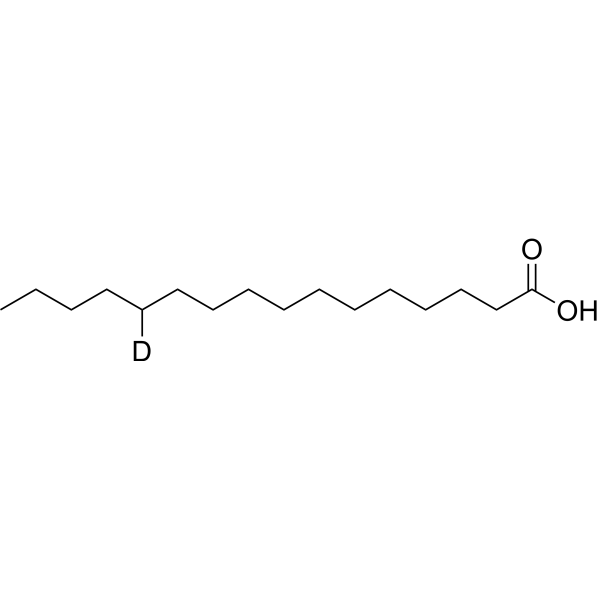
-
- HY-N0390S1
-
|
L-Glutamic acid 5-amide-13C5
|
mGluR
Endogenous Metabolite
Ferroptosis
|
Metabolic Disease
|
|
L-Glutamine- 13C5 is the 13C-labeled L-Glutamine. L-Glutamine (L-Glutamic acid 5-amide) is a non-essential amino acid present abundantly throughout the body and involved in many metabolic processes. L-Glutamine provides a source of carbons for oxidation in some cells[1][2].
|
-

-
- HY-77813S
-
|
|
Bacterial
Apoptosis
Antibiotic
|
Endocrinology
Cancer
|
|
Benzyl isothiocyanate-d7 is the deuterium labeled Benzyl isothiocyanate. Benzyl isothiocyanate is a member of natural isothiocyanates with antimicrobial activity[1][2]. Benzyl isothiocyanate potent inhibits cell mobility, migration and invasion nature and matrix metalloproteinase-2 (MMP-2) activity of murine melanoma cells[2].
|
-
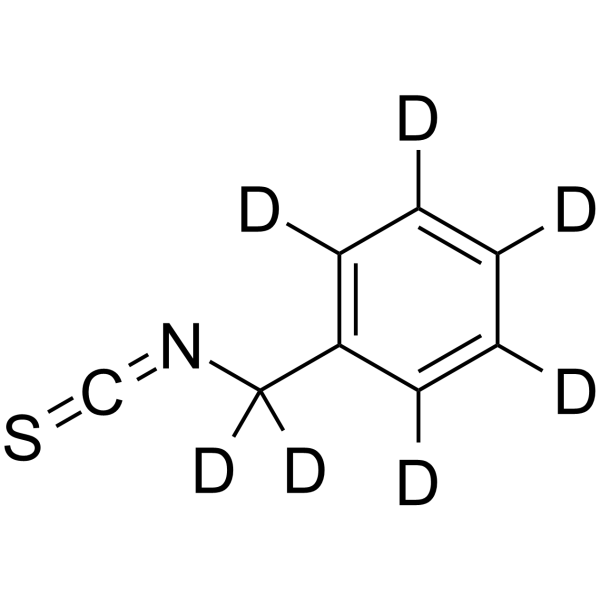
-
- HY-N0830S5
-
-
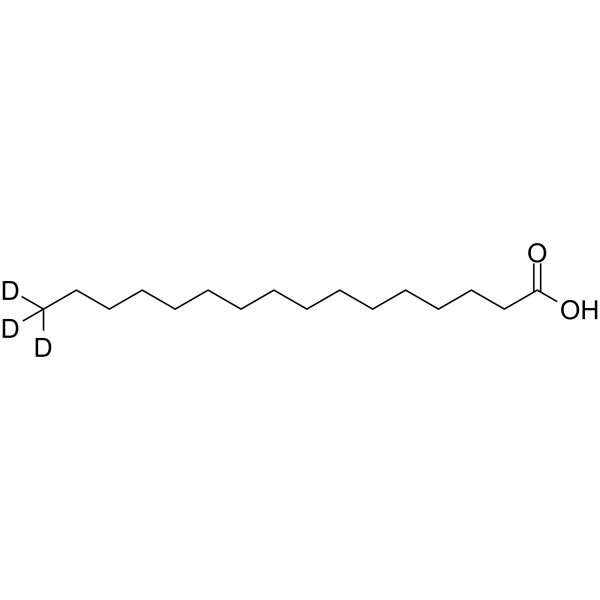
-
- HY-17406S
-
|
Ro 40-7592 d7
|
Isotope-Labeled Compounds
COMT
Amyloid-β
|
Neurological Disease
|
|
Tolcapone-d7 is a deuterium labeled Tolcapone. Tolcapone is a selective, potent and orally active COMT inhibitor. Tolcapone is also a potent inhibitor of α-syn and Aβ42 oligomerization and fibrillogenesis and protect against extracellular toxicity induced by the aggregation of both proteins in PC12 cells[1][2].
|
-

-
- HY-N0830S2
-
-
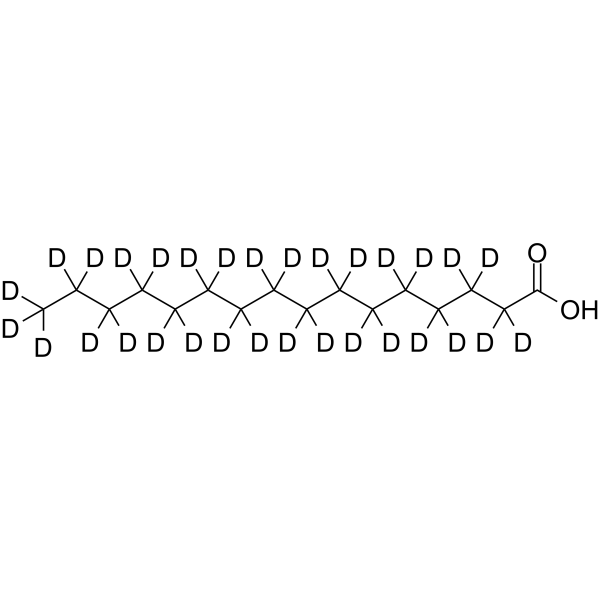
-
- HY-N0830BS
-
-
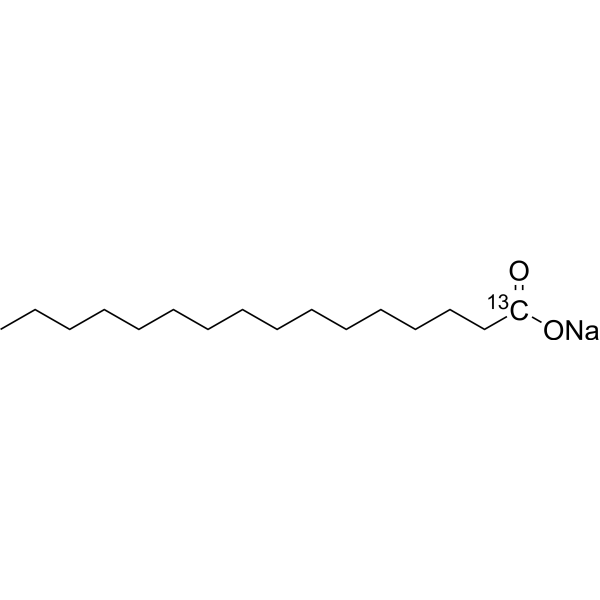
-
- HY-N0830S4
-
|
|
HSP
|
Cardiovascular Disease
Neurological Disease
Metabolic Disease
Cancer
|
|
Palmitic acid-d2 is the deuterium labeled Palmitic acid. Palmitic acid is a long-chain saturated fatty acid commonly found in both animals and plants. Palmitic acid can induce the expression of glucose-regulated protein 78 (GRP78) and CCAAT/enhancer binding protein homologous protein (CHOP) in in mouse granulosa cells[1][2].
|
-
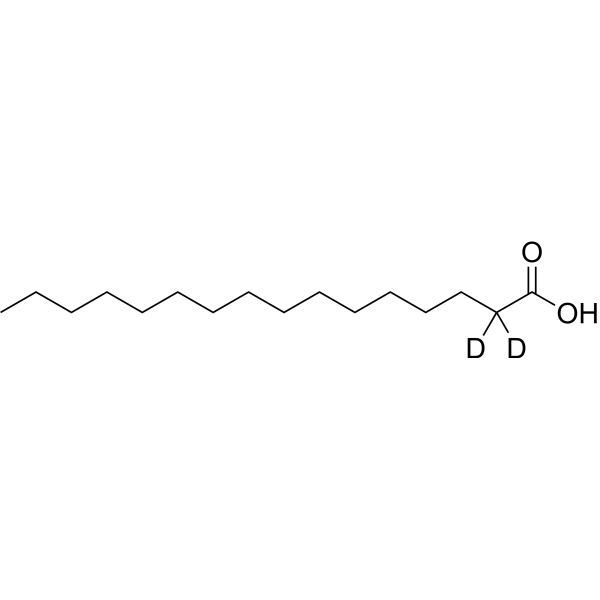
-
- HY-N0830S7
-
|
|
HSP
|
Cardiovascular Disease
Neurological Disease
Metabolic Disease
Cancer
|
|
Palmitic acid-d4 is the deuterium labeled Palmitic acid. Palmitic acid is a long-chain saturated fatty acid commonly found in both animals and plants. Palmitic acid can induce the expression of glucose-regulated protein 78 (GRP78) and CCAAT/enhancer binding protein homologous protein (CHOP) in in mouse granulosa cells[1][2].
|
-
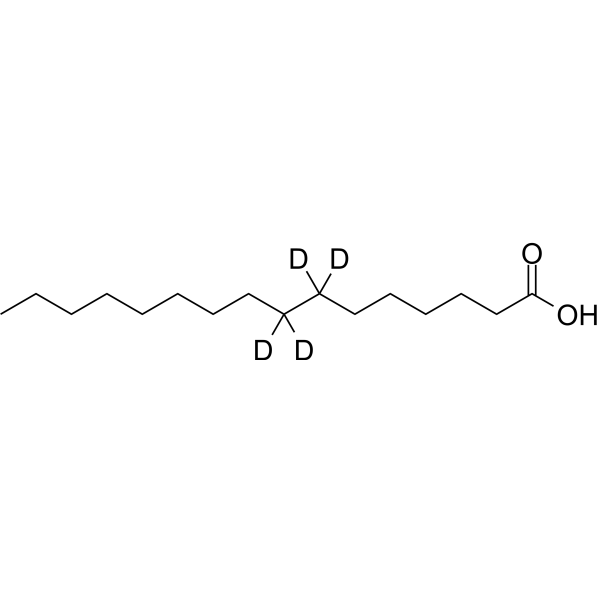
-
- HY-N0830S9
-
|
|
HSP
|
Cardiovascular Disease
Neurological Disease
Metabolic Disease
Cancer
|
|
Palmitic acid- 13C is the 13C-labeled Palmitic acid. Palmitic acid is a long-chain saturated fatty acid commonly found in both animals and plants. Palmitic acid can induce the expression of glucose-regulated protein 78 (GRP78) and CCAAT/enhancer binding protein homologous protein (CHOP) in in mouse granulosa cells[1][2].
|
-
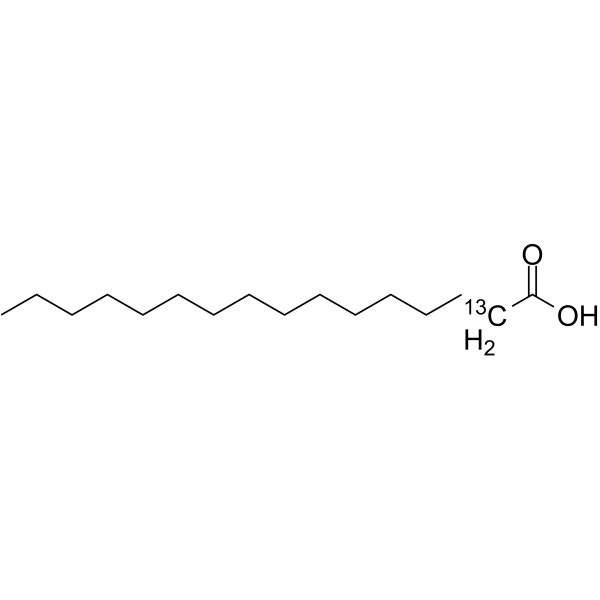
-
- HY-N0390S4
-
|
L-Glutamic acid 5-amide-5-13C
|
mGluR
Endogenous Metabolite
Ferroptosis
|
Metabolic Disease
|
|
L-Glutamine-5- 13C is the 13C-labeled L-Glutamine. L-Glutamine (L-Glutamic acid 5-amide) is a non-essential amino acid present abundantly throughout the body and involved in many metabolic processes. L-Glutamine provides a source of carbons for oxidation in some cells[1][2].
|
-
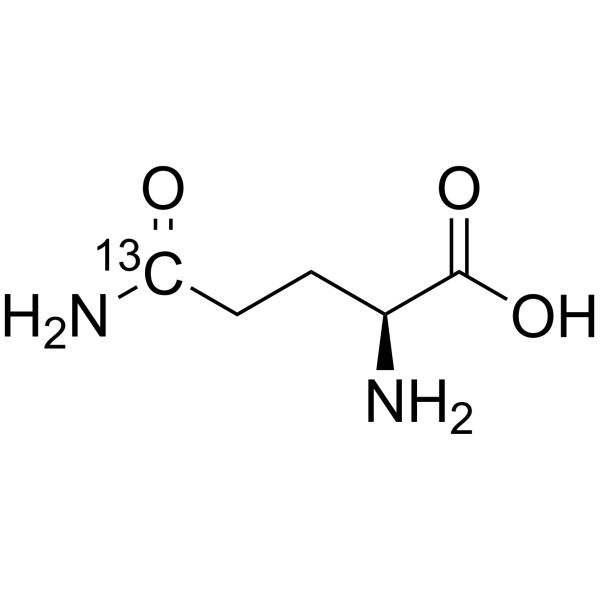
-
- HY-N0390S5
-
|
L-Glutamic acid 5-amide-1-13C
|
mGluR
Endogenous Metabolite
Ferroptosis
|
Metabolic Disease
|
|
L-Glutamine-1- 13C is the 13C-labeled L-Glutamine. L-Glutamine (L-Glutamic acid 5-amide) is a non-essential amino acid present abundantly throughout the body and involved in many metabolic processes. L-Glutamine provides a source of carbons for oxidation in some cells[1][2].
|
-
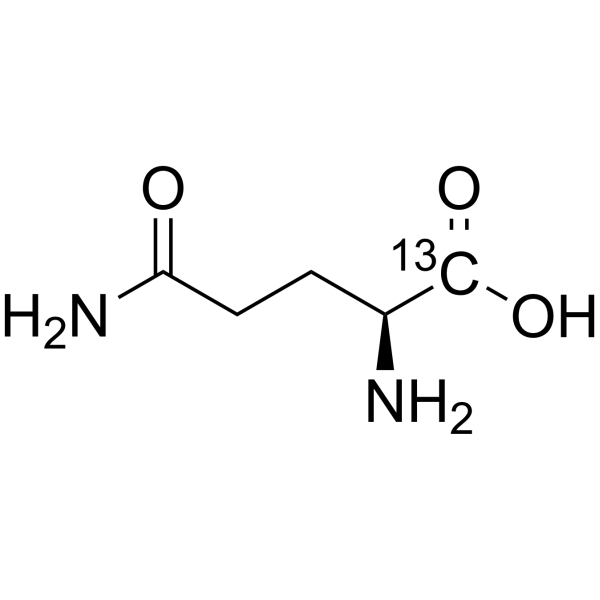
-
- HY-N0390S8
-
|
L-Glutamic acid 5-amide-15N2
|
mGluR
Endogenous Metabolite
Ferroptosis
|
Metabolic Disease
|
|
L-Glutamine- 15N2 is the 15N-labeled L-Glutamine. L-Glutamine (L-Glutamic acid 5-amide) is a non-essential amino acid present abundantly throughout the body and involved in many metabolic processes. L-Glutamine provides a source of carbons for oxidation in some cells[1][2].
|
-

-
- HY-N0390S11
-
-
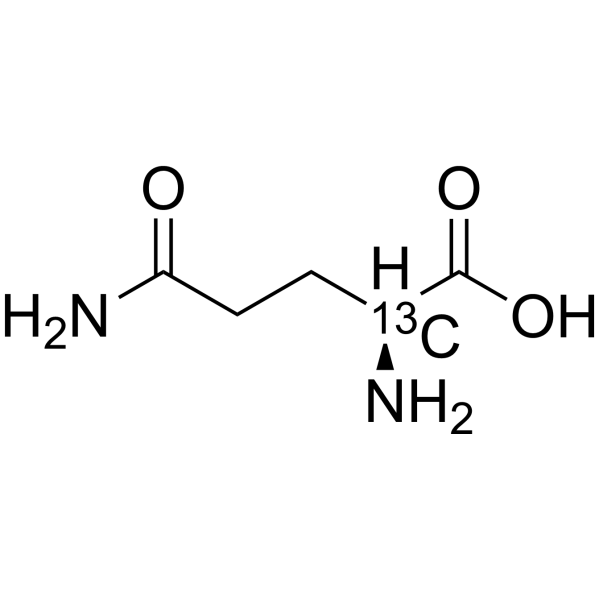
-
- HY-N0830S14
-
|
|
Isotope-Labeled Compounds
HSP
Endogenous Metabolite
|
Inflammation/Immunology
|
|
Palmitic acid-d17 is the deuterium labeled Palmitic acid. Palmitic acid is a long-chain saturated fatty acid commonly found in both animals and plants. PA can induce the expression of glucose-regulated protein 78 (GRP78) and CCAAT/enhancer binding protein homologous protein (CHOP) in in mouse granulosa cells[1][2].
|
-
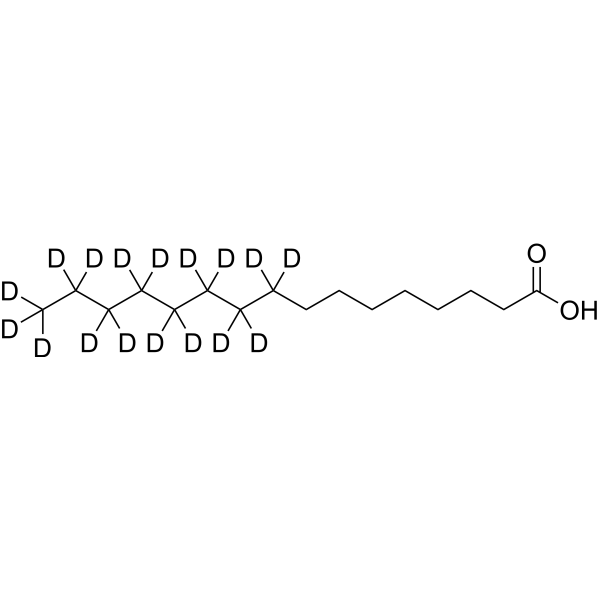
-
- HY-N0830S20
-
|
|
Isotope-Labeled Compounds
HSP
Endogenous Metabolite
|
|
|
Palmitic acid-d9 is the deuterium labeled Palmitic acid. Palmitic acid is a long-chain saturated fatty acid commonly found in both animals and plants. PA can induce the expression of glucose-regulated protein 78 (GRP78) and CCAAT/enhancer binding protein homologous protein (CHOP) in in mouse granulosa cells[1][2].
|
-
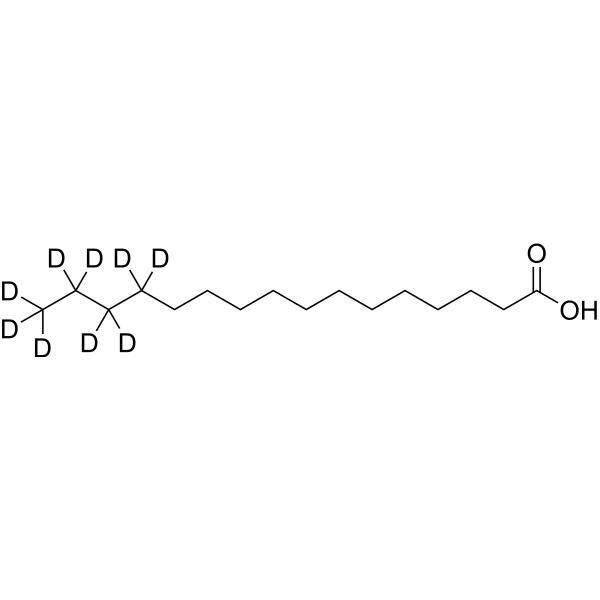
-
- HY-N0830S21
-
|
|
Isotope-Labeled Compounds
HSP
Endogenous Metabolite
|
|
|
Palmitic acid-d5 is the deuterium labeled Palmitic acid. Palmitic acid is a long-chain saturated fatty acid commonly found in both animals and plants. PA can induce the expression of glucose-regulated protein 78 (GRP78) and CCAAT/enhancer binding protein homologous protein (CHOP) in in mouse granulosa cells[1][2].
|
-
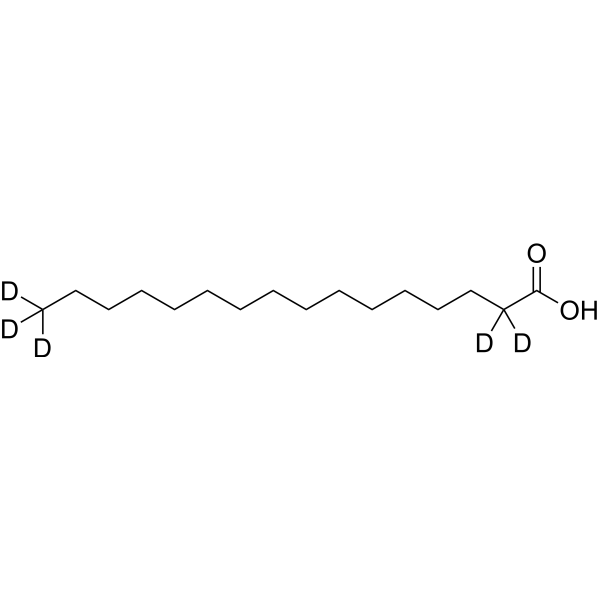
-
- HY-N0830S6
-
-
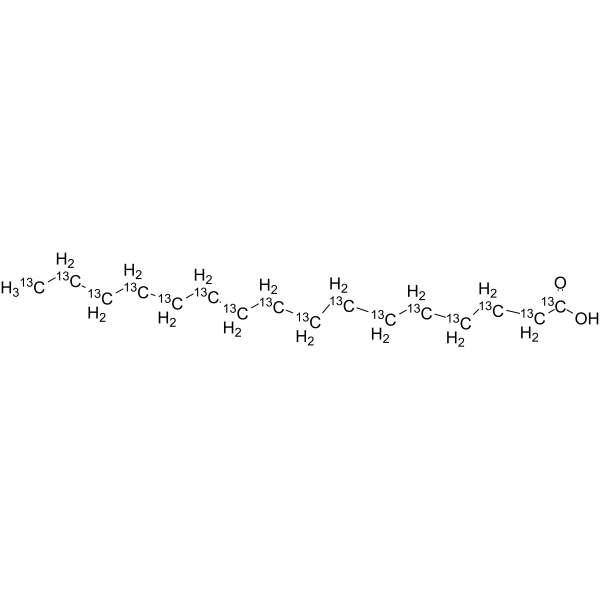
- HY-W008449S
-
|
|
Endogenous Metabolite
|
Cancer
|
|
1-Methylxanthine- 13C,d3 is the 13C- and deuterium labeled 1-Methylxanthine. 1-Methylxanthine, a caffeine derivative, is an essential human urinary metabolite of caffeine and theophylline (1,3-dimethylxanthine, TP)[1]. 1-Methylxanthine enhances the radiosensitivity of tumor cells[2].
|
-
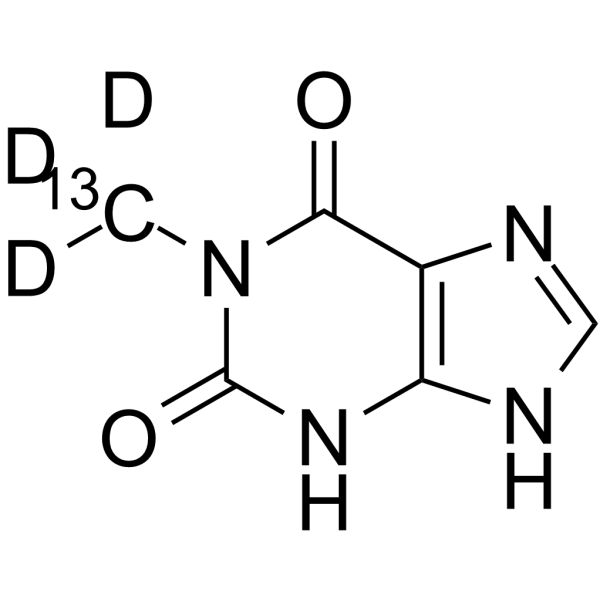
- HY-N0830BS1
-
-
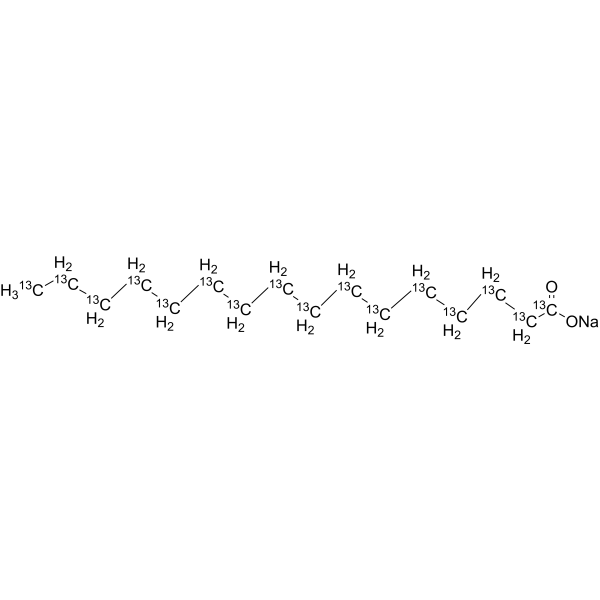
- HY-N0830S10
-
|
|
HSP
|
Cardiovascular Disease
Neurological Disease
Metabolic Disease
Cancer
|
|
Palmitic acid- 13C2 is the 13C-labeled Palmitic acid. Palmitic acid is a long-chain saturated fatty acid commonly found in both animals and plants. Palmitic acid can induce the expression of glucose-regulated protein 78 (GRP78) and CCAAT/enhancer binding protein homologous protein (CHOP) in in mouse granulosa cells[1][2].
|
-

- HY-N0830S11
-
|
|
HSP
|
Cardiovascular Disease
Neurological Disease
Metabolic Disease
Cancer
|
|
Palmitic acid-d2-1 is the deuterium labeled Palmitic acid. Palmitic acid is a long-chain saturated fatty acid commonly found in both animals and plants. Palmitic acid can induce the expression of glucose-regulated protein 78 (GRP78) and CCAAT/enhancer binding protein homologous protein (CHOP) in in mouse granulosa cells[1][2].
|
-
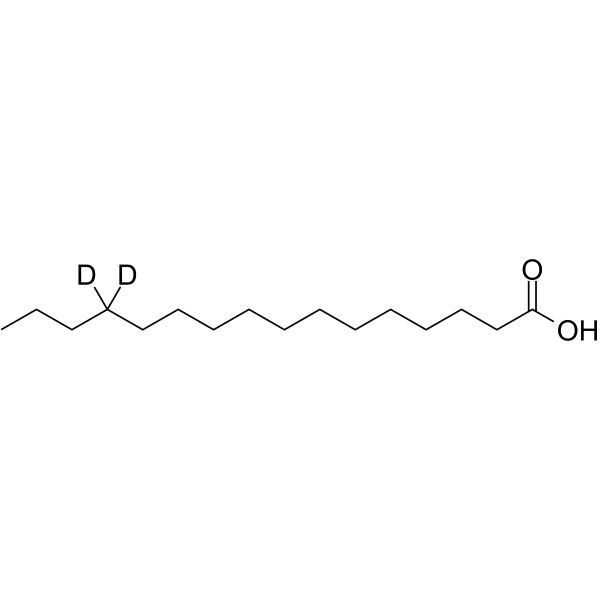
- HY-N0390S9
-
|
L-Glutamic acid 5-amide-15N-1
|
mGluR
Endogenous Metabolite
Ferroptosis
|
Metabolic Disease
|
|
L-Glutamine- 15N-1 is the 15N-labeled L-Glutamine. L-Glutamine (L-Glutamic acid 5-amide) is a non-essential amino acid present abundantly throughout the body and involved in many metabolic processes. L-Glutamine provides a source of carbons for oxidation in some cells[1][2].
|
-
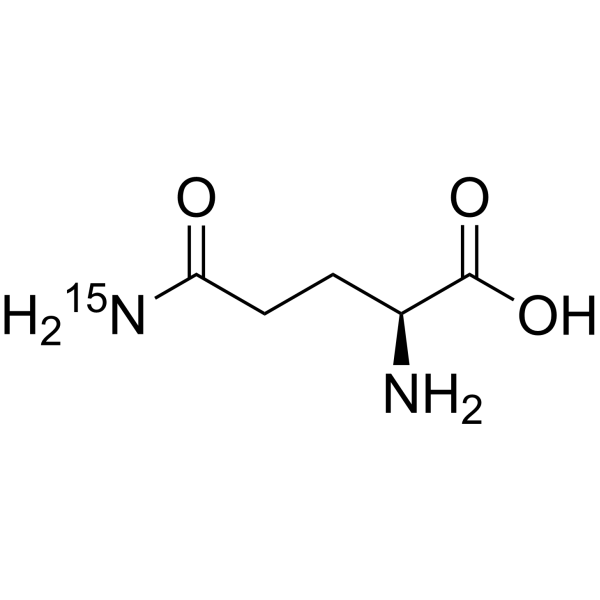
- HY-N0390S10
-
|
L-Glutamic acid 5-amide-1,2-13C2
|
Isotope-Labeled Compounds
mGluR
Endogenous Metabolite
Ferroptosis
|
Metabolic Disease
|
|
L-Glutamine-1,2- 13C2 is the 13C-labeled L-Glutamine. L-Glutamine (L-Glutamic acid 5-amide) is a non-essential amino acid present abundantly throughout the body and involved in many metabolic processes. L-Glutamine provides a source of carbons for oxidation in some cells[1][2].
|
-

- HY-113365S
-
|
4-Cholesten-3-one-d5
|
Endogenous Metabolite
|
|
|
Cholestenone-d5 is the deuterium labeled Cholestenone. Cholestenone (4-Cholesten-3-one), the intermediate oxidation product of cholesterol, is metabolized primarily in the liver. Cholestenone is highly mobile in membranes and influences cholesterol flip-flop and efflux. Cholestenone may cause long-term functional defects in cells[1][2][3].
|
-

- HY-113365S1
-
|
4-Cholesten-3-one-13C
|
Endogenous Metabolite
|
|
|
Cholestenone- 13C is the 13C labeled Cholestenone. Cholestenone (4-Cholesten-3-one), the intermediate oxidation product of cholesterol, is metabolized primarily in the liver. Cholestenone is highly mobile in membranes and influences cholesterol flip-flop and efflux. Cholestenone may cause long-term functional defects in cells[1][2][3].
|
-
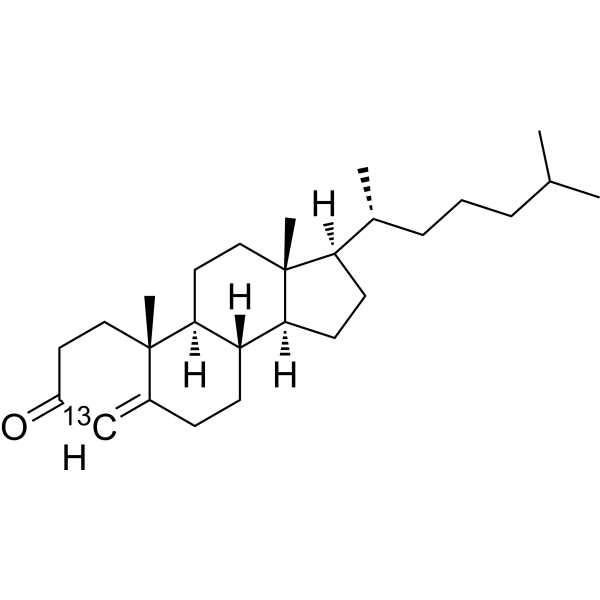
- HY-N0830S12
-
|
|
HSP
Endogenous Metabolite
|
Cancer
|
|
Palmitic acid-d4-1 is the deuterium labeled Palmitic acid. Palmitic acid is a long-chain saturated fatty acid commonly found in both animals and plants. PA can induce the expression of glucose-regulated protein 78 (GRP78) and CCAAT/enhancer binding protein homologous protein (CHOP) in in mouse granulosa cells[1][2][3].
|
-
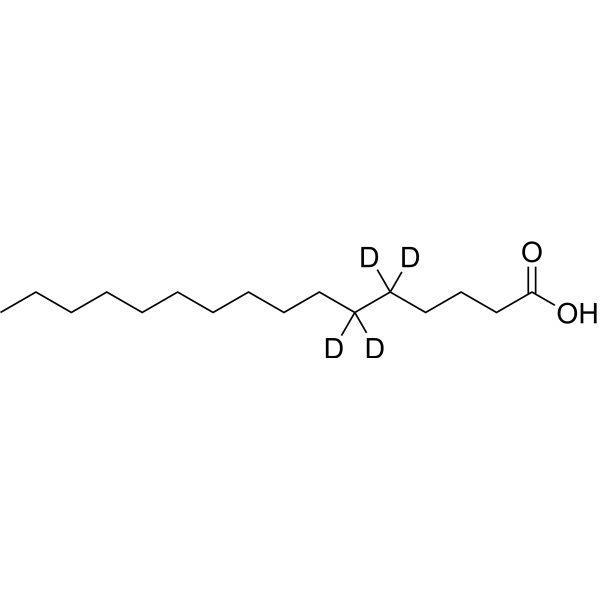
- HY-N0830S13
-
|
|
Isotope-Labeled Compounds
HSP
Endogenous Metabolite
|
|
|
Palmitic acid-d4-2 is the deuterium labeled Palmitic acid. Palmitic acid is a long-chain saturated fatty acid commonly found in both animals and plants. PA can induce the expression of glucose-regulated protein 78 (GRP78) and CCAAT/enhancer binding protein homologous protein (CHOP) in in mouse granulosa cells[1][2].
|
-
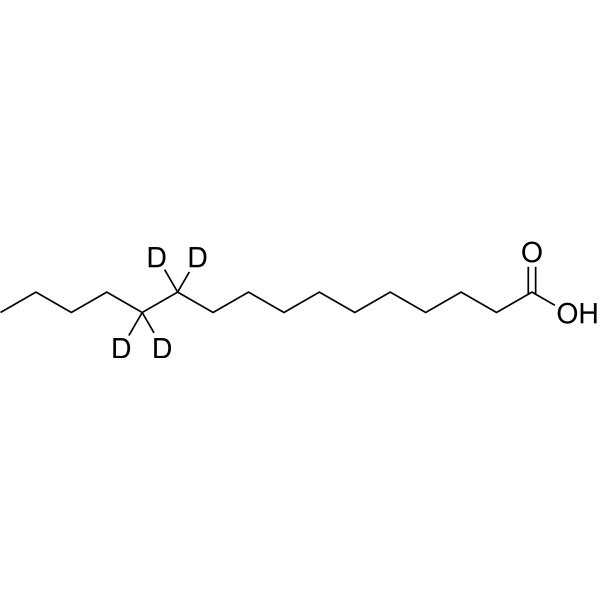
- HY-N0830S15
-
|
|
Isotope-Labeled Compounds
HSP
Endogenous Metabolite
|
Cancer
|
|
Palmitic acid-d2-2 is the deuterium labeled Palmitic acid. Palmitic acid is a long-chain saturated fatty acid commonly found in both animals and plants. PA can induce the expression of glucose-regulated protein 78 (GRP78) and CCAAT/enhancer binding protein homologous protein (CHOP) in in mouse granulosa cells[1][2].
|
-
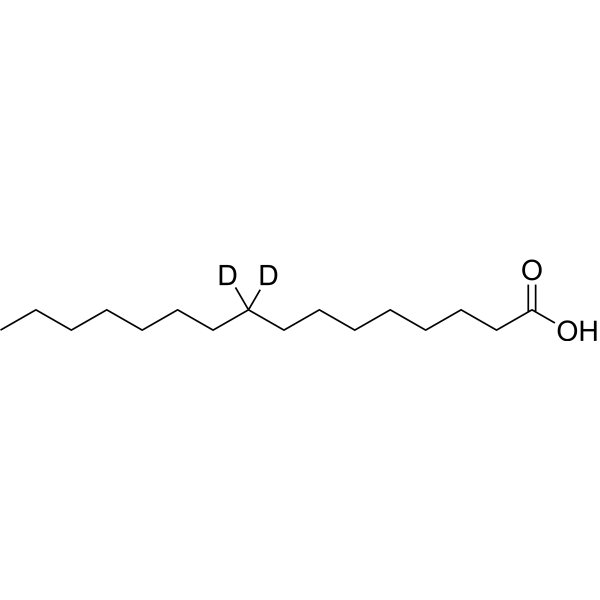
- HY-N0830S16
-
|
|
Isotope-Labeled Compounds
HSP
Endogenous Metabolite
|
Cancer
|
|
Palmitic acid-d2-3 is the deuterium labeled Palmitic acid. Palmitic acid is a long-chain saturated fatty acid commonly found in both animals and plants. PA can induce the expression of glucose-regulated protein 78 (GRP78) and CCAAT/enhancer binding protein homologous protein (CHOP) in in mouse granulosa cells[1][2].
|
-
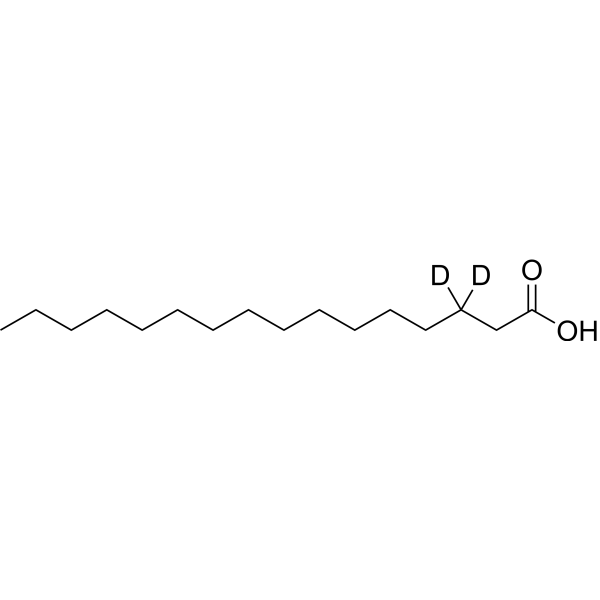
- HY-N0830S17
-
|
|
Isotope-Labeled Compounds
HSP
Endogenous Metabolite
|
|
|
Palmitic acid-d2-4 is the deuterium labeled Palmitic acid. Palmitic acid is a long-chain saturated fatty acid commonly found in both animals and plants. PA can induce the expression of glucose-regulated protein 78 (GRP78) and CCAAT/enhancer binding protein homologous protein (CHOP) in in mouse granulosa cells[1][2].
|
-
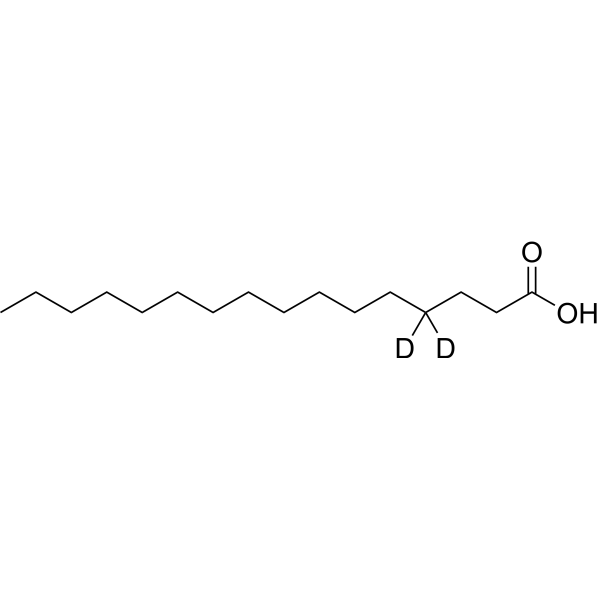
- HY-N0830S19
-
|
|
Isotope-Labeled Compounds
HSP
Endogenous Metabolite
|
|
|
Palmitic acid-d2-5 is the deuterium labeled Palmitic acid. Palmitic acid is a long-chain saturated fatty acid commonly found in both animals and plants. PA can induce the expression of glucose-regulated protein 78 (GRP78) and CCAAT/enhancer binding protein homologous protein (CHOP) in in mouse granulosa cells[1][2].
|
-
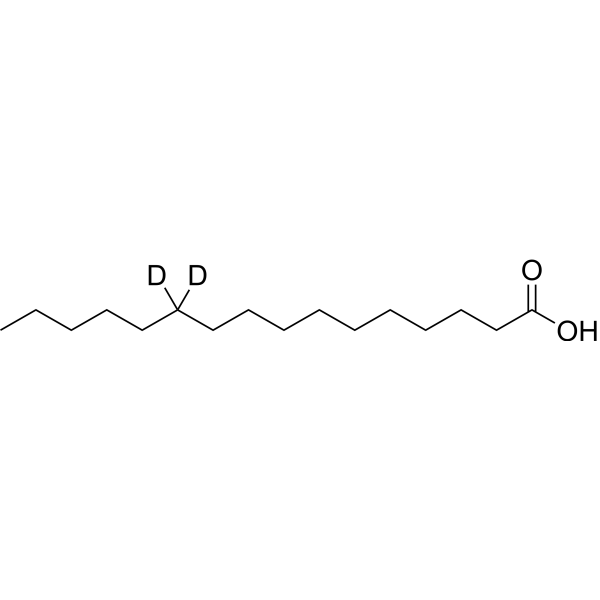
- HY-14397S
-
|
Indometacin-d4
|
Isotope-Labeled Compounds
COX
Autophagy
|
Inflammation/Immunology
Cancer
|
|
Indomethacin-d4 is a deuterium labeled Indomethacin. Indomethacin is a potent, blood-brain permeable and nonselective inhibitor of COX1 and COX2, with IC50s of 18 nM and 26 nM for human COX-1 and COX-2, respectively, in CHO cells[1]. Indomethacin disrupts autophagic flux by disturbing the normal functioning of lysosomes[2].
|
-

- HY-N0830S3
-
|
|
HSP
|
Cardiovascular Disease
Neurological Disease
Metabolic Disease
Cancer
|
|
Palmitic acid-1- 13C is the 13C-labeled Palmitic acid. Palmitic acid is a long-chain saturated fatty acid commonly found in both animals and plants. Palmitic acid can induce the expression of glucose-regulated protein 78 (GRP78) and CCAAT/enhancer binding protein homologous protein (CHOP) in in mouse granulosa cells[1][2].
|
-
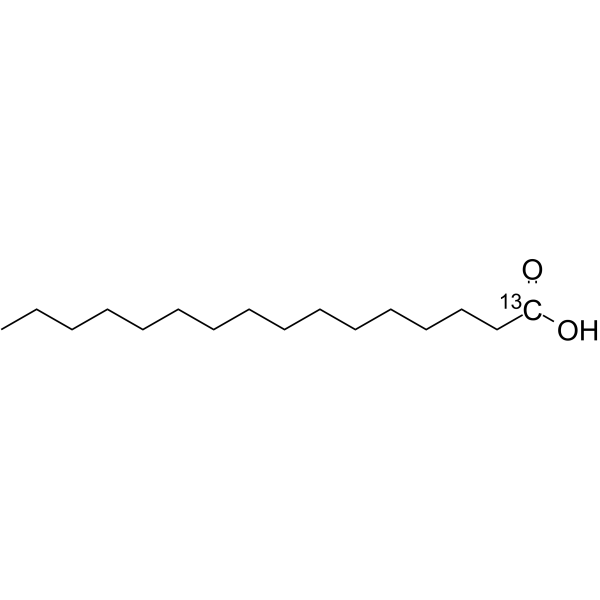
- HY-N0830S8
-
-
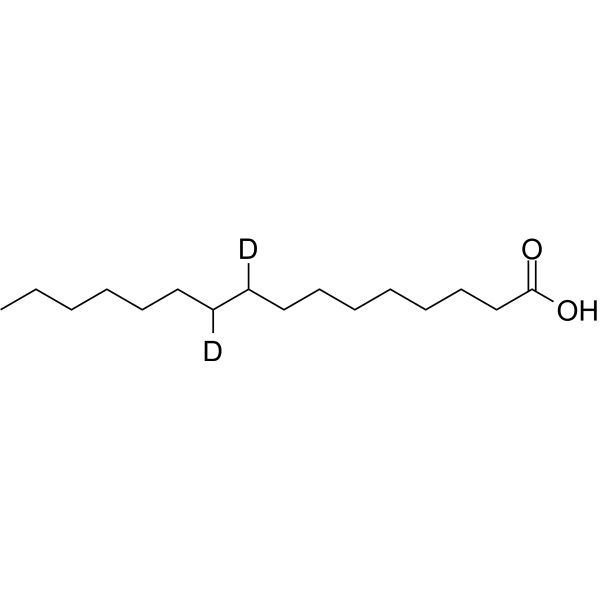
- HY-N0390S6
-
|
L-Glutamic acid 5-amide-13C5,15N2
|
mGluR
Endogenous Metabolite
Ferroptosis
|
Metabolic Disease
|
|
L-Glutamine- 13C5, 15N2 is the 13C- and 15N-labeled L-Glutamine. L-Glutamine (L-Glutamic acid 5-amide) is a non-essential amino acid present abundantly throughout the body and involved in many metabolic processes. L-Glutamine provides a source of carbons for oxidation in some cells[1][2].
|
-

- HY-113365S2
-
|
4-Cholesten-3-one-13C2
|
Isotope-Labeled Compounds
Endogenous Metabolite
|
|
|
Cholestenone- 13C2 is the 13C labeled Cholestenone. Cholestenone (4-Cholesten-3-one), the intermediate oxidation product of cholesterol, is metabolized primarily in the liver. Cholestenone is highly mobile in membranes and influences cholesterol flip-flop and efflux. Cholestenone may cause long-term functional defects in cells[1][2][3].
|
-

- HY-14397S1
-
|
|
COX
Autophagy
|
Inflammation/Immunology
Cancer
|
|
Indomethacin-d4 Methyl Ester is the deuterium labeled Indomethacin. Indomethacin (Indometacin) is a potent, blood-brain permeable and nonselective inhibitor of COX1 and COX2, with IC50s of 18 nM and 26 nM for human COX-1 and COX-2, respectively, in CHO cells[1]. Indomethacin disrupts autophagic flux by disturbing the normal functioning of lysosomes[2].
|
-

- HY-W008449S1
-
|
|
Endogenous Metabolite
|
Cancer
|
|
1-Methylxanthine- 13C4, 15N3 is the 13C-labeled and 15N-labeled 1-Methylxanthine. 1-Methylxanthine, a caffeine derivative, is an essential human urinary metabolite of caffeine and theophylline (1,3-dimethylxanthine, TP)[1]. 1-Methylxanthine enhances the radiosensitivity of tumor cells[2].
|
-
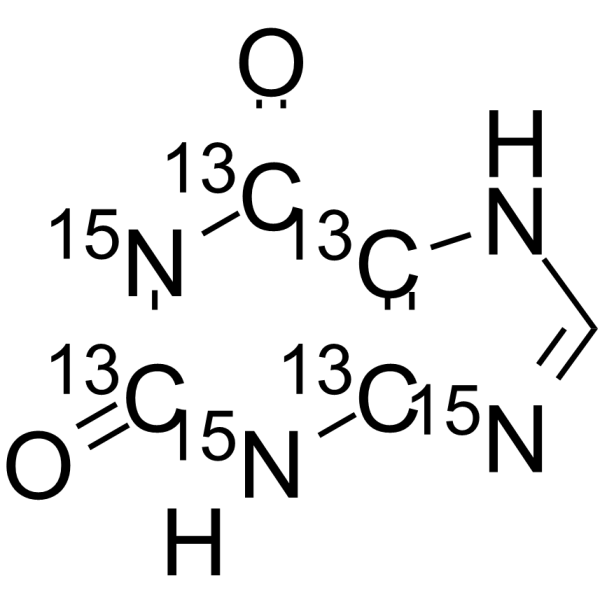
- HY-N0390S7
-
|
L-Glutamic acid 5-amide-15N2,d5
|
Isotope-Labeled Compounds
mGluR
Endogenous Metabolite
Ferroptosis
|
Metabolic Disease
|
|
L-Glutamine- 15N2,d5 is the deuterium and 15N-labeled L-Glutamine. L-Glutamine (L-Glutamic acid 5-amide) is a non-essential amino acid present abundantly throughout the body and involved in many metabolic processes. L-Glutamine provides a source of carbons for oxidation in some cells[1][2].
|
-

- HY-B1448AS
-
|
|
Apoptosis
Calcium Channel
|
Cardiovascular Disease
|
|
(Rac)-Benidipine-d7 is the deuterium labeled Benidipine[1]. Benidipine is a potent and orally active calcium channel antagonist[2]. Benidipine shows anti-apoptosis effects in ischaemic/reperfused myocardial cells[3]. Benidipine increases the activity of endothelial cell-type nitric oxide synthase and improves coronary circulation in hypertensive rats[4].
|
-
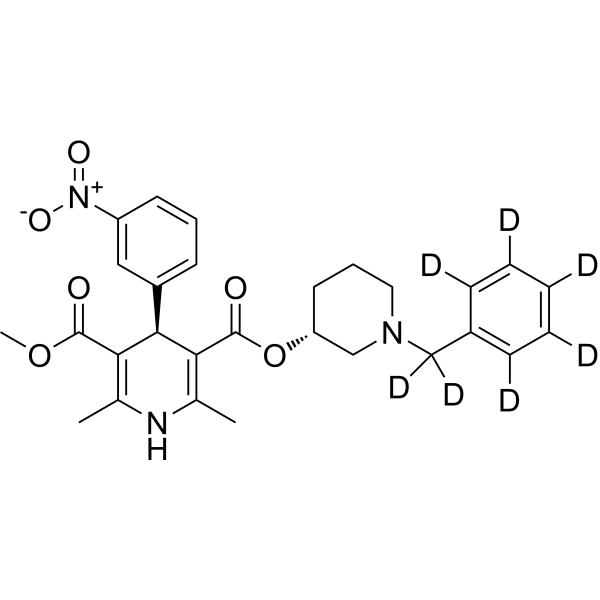
- HY-N0830S1
-
-
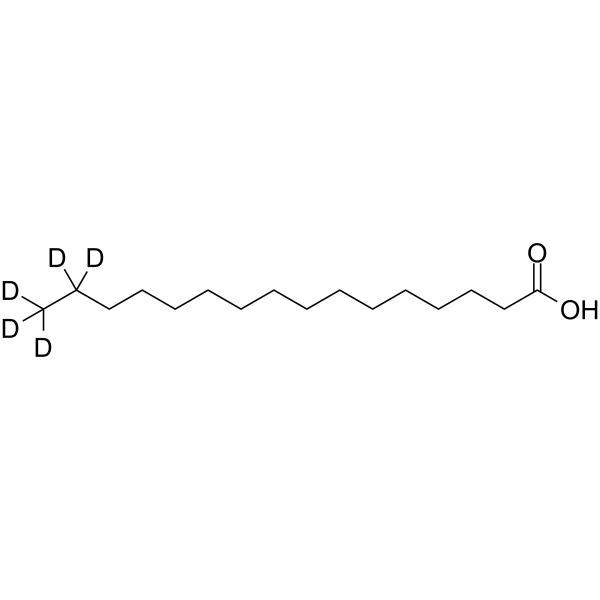
- HY-113134S
-
|
25-OHC-d6
|
Isotope-Labeled Compounds
Endogenous Metabolite
|
Inflammation/Immunology
|
|
25-Hydroxycholesterol-d6 (25-OHC-d6) is the deuterium labeled 25-Hydroxycholesterol. 25-Hydroxycholesterol is a metabolite of cholesterol that is produced and secreted by macrophages in response to Toll-like receptor (TLR) activation. 25-hydroxycholesterol is a potent (EC50≈65 nM) and selective suppressor of IgA production by B cells[1][2].
|
-

- HY-N0830S
-
-
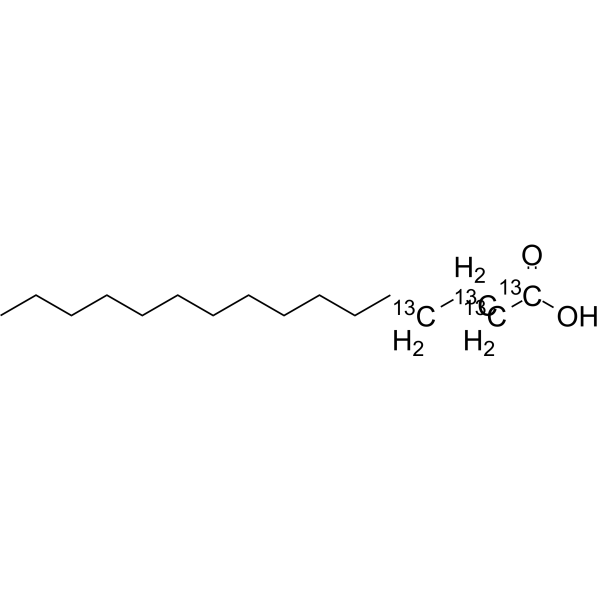
- HY-15455S
-
|
APTA-2217-d4; BYK 20869-d4; B9302-107-d4
|
Isotope-Labeled Compounds
Phosphodiesterase (PDE)
RSV
|
Inflammation/Immunology
|
|
Roflumilast-d4 is the deuterium labeled Roflumilast. Roflumilast is a selective PDE4 inhibitor with IC50s of 0.7, 0.9, 0.7, and 0.2 nM for PDE4A1, PDEA4, PDEB1, and PDEB2, respectively, without affecting PDE1, PDE2, PDE3 or PDE5 isoenzymes from various cells[1][2].
|
-

- HY-14904AS
-
|
|
Isotope-Labeled Compounds
Influenza Virus
SARS-CoV
|
Infection
|
|
Umifenovir-d6 (hydrochloride) is the deuterium labeled Umifenovir hydrochloride. Umifenovir hydrochloride is a potent, orally active broad-spectrum antiviral with activity against a number of enveloped and non-enveloped viruses. Umifenovir hydrochloride is used as an anti-influenza virus agent. Umifenovir hydrochloride could effectively inhibit the fusion of virus with host cells[1][2]. Umifenovir hydrochloride is an efficient inhibitor of SARS-CoV-2 in vitro. Anti-inflammatory activity[3].
|
-
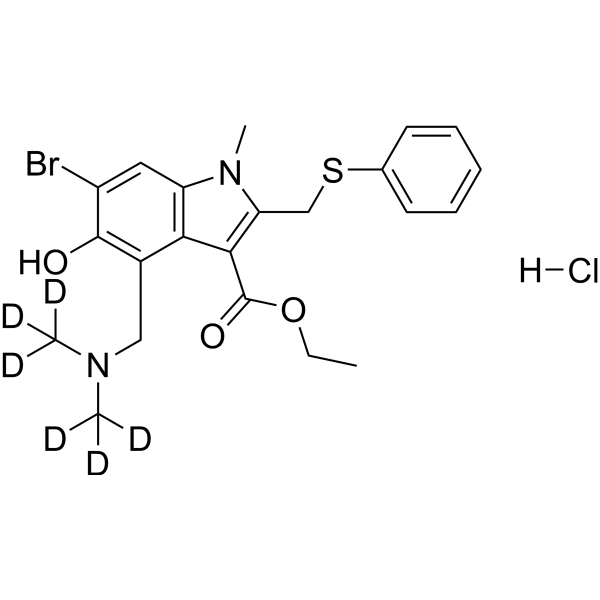
- HY-N0390S3
-
|
L-Glutamic acid 5-amide-13C5,15N2,d5
|
mGluR
Endogenous Metabolite
Ferroptosis
|
Metabolic Disease
|
|
L-Glutamine- 13C5, 15N2,d5 is the deuterium, 13C-, and 15-labeled L-Glutamine. L-Glutamine (L-Glutamic acid 5-amide) is a non-essential amino acid present abundantly throughout the body and involved in many metabolic processes. L-Glutamine provides a source of carbons for oxidation in some cells[1][2].
|
-

- HY-15455S1
-
|
|
Phosphodiesterase (PDE)
RSV
|
Inflammation/Immunology
|
|
Roflumilast-d4 N-Oxide is the deuterium labeled Roflumilast. Roflumilast is a selective PDE4 inhibitor with IC50s of 0.7, 0.9, 0.7, and 0.2 nM for PDE4A1, PDEA4, PDEB1, and PDEB2, respectively, without affecting PDE1, PDE2, PDE3 or PDE5 isoenzymes from various cells[1][2].
|
-
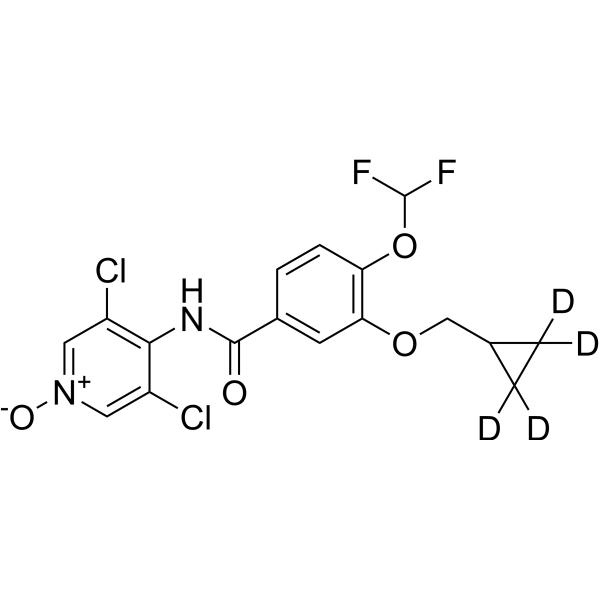
- HY-N0492S
-
-

- HY-A0067S
-
|
|
RAR/RXR
Apoptosis
Autophagy
|
Neurological Disease
|
|
Oxybenzone-d5 is the deuterium labeled Oxybenzone[1]. Oxybenzone (Benzophenone 3) is a commonly used UV filter in sun tans and skin protectants. Oxybenzone act as endocrine disrupting chemicals (EDCs) and can pass through the placental and blood-brain barriers. Benzophenone-3 impairs autophagy, alters epigenetic status, and disrupts retinoid X receptor signaling in apoptotic neuronal cells[2][3][4].
|
-

- HY-16560S
-
|
Campathecin-d5; (S)-(+)-Camptothecin-d5; CPT-d5
|
Topoisomerase
ADC Cytotoxin
MicroRNA
Influenza Virus
Apoptosis
Fungal
Antibiotic
|
Infection
Cancer
|
|
Camptothecin-d5 is the deuterium labeled Camptothecin. Camptothecin (CPT), a kind of alkaloid, is a DNA topoisomerase I (Topo I) inhibitor with an IC50 of 679 nM[1]. Camptothecin (CPT) exhibits powerful antineoplastic activity against colorectal, breast, lung and ovarian cancers, modulates hypoxia-inducible factor-1α (HIF-1α) activity by changing microRNAs (miRNA) expression patterns in human cancer cells[2][3].
|
-

- HY-17372S
-
|
|
Isotope-Labeled Compounds
COX
|
Inflammation/Immunology
Cancer
|
|
Rofecoxib-d5 is the deuterium labeled Rofecoxib. Rofecoxib is a potent, specific and orally active COX-2 inhibitor, with IC50s of 26 and 18 nM for human COX-2 in human osteosarcoma cells and Chinese hamster ovary cells, with a 1000-fold selectivity for COX-2 over human COX-1 (IC50 > 50 μM in U937 cells and > 15 μM in Chinese hamster ovary cells)[1][2].
|
-

- HY-N4126
-
|
|
Anaplastic lymphoma kinase (ALK)
|
Neurological Disease
Inflammation/Immunology
Cancer
|
|
6-Demethoxytangeretin is a citrus flavonoid isolated from Citrus reticulata. 6-Demethoxytangeretin exerts anti-inflammatory activity and anti-allergic activity, suppresses production and gene expression of interleukin-6 in human mast cell-1 via anaplastic lymphoma kinase (ALK) and mitogen-activated protein kinase (MAPK) pathways . 6-Demethoxytangeretin facilitates the CRE-mediated transcription associated with learning and memory in cultured hippocampal neurons .
|
-
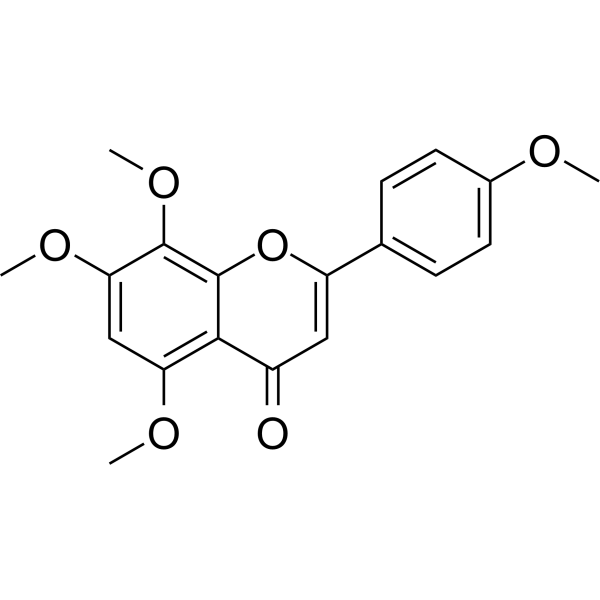
- HY-101329S
-
|
9-Anthracenecarboxylic acid-d9
|
Chloride Channel
|
Others
|
|
Anthracene-9-carboxylic acid-d9 is the deuterium labeled Anthracene-9-carboxylic acid[1]. Anthracene-9-carboxylic acid (9-Anthracenecarboxylic acid) is an anthracene derivative traditionally used to block and identify Ca2+-activated Cl- currents (CaCCs) in various cell types, like diverse smooth muscle cells, epithelial cells and salivary gland cells[2].
|
-

- HY-15037S1
-
|
|
COX
Apoptosis
|
Inflammation/Immunology
|
|
Diclofenac-d4 (sodium) is the deuterium labeled Diclofenac sodium. Diclofenac Sodium (GP 45840) is a potent and nonselective anti-inflammatory agent, acts as a COX inhibitor, with IC50s of 4 and 1.3 nM for human COX-1 and COX-2 in CHO cells[1], and 5.1 and 0.84 μM for ovine COX-1 and COX-2, respectively[2]. Diclofenac Sodium induces apoptosis of neural stem cells (NSCs) via the activation of the caspase cascade[3].
|
-
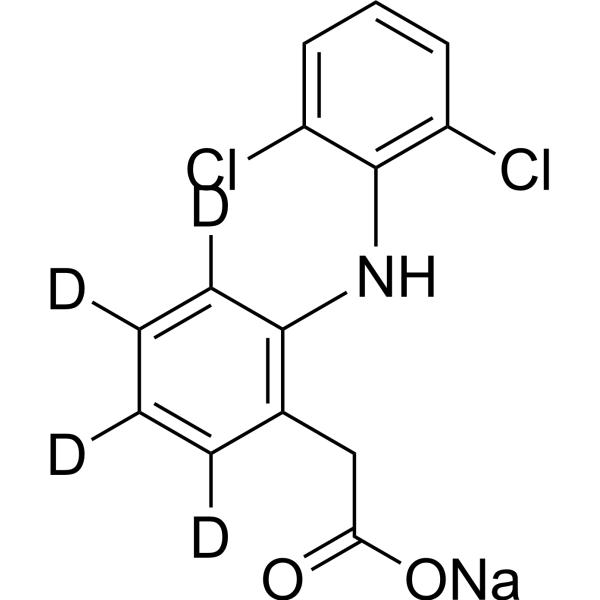
- HY-15036S
-
|
|
Isotope-Labeled Compounds
COX
Apoptosis
|
Inflammation/Immunology
|
|
Diclofenac-d4 is the deuterium labeled Diclofenac. Diclofenac is a potent and nonselective anti-inflammatory agent, acts as a COX inhibitor, with IC50s of 4 and 1.3 nM for human COX-1 and COX-2 in CHO cells[1], and 5.1 and 0.84 μM for ovine COX-1 and COX-2, respectively[2]. Diclofenac induces apoptosis of neural stem cells (NSCs) via the activation of the caspase cascade[3].
|
-

- HY-100490S
-
|
|
Isotope-Labeled Compounds
Imidazoline Receptor
Adrenergic Receptor
Apoptosis
Autophagy
|
Cardiovascular Disease
Cancer
|
|
Rilmenidine-d4 is the deuterium labeled Rilmenidine. Rilmenidine, an innovative antihypertensive agent, is an orally active, selective I1 imidazoline receptor agonist. Rilmenidine is an alpha 2-adrenoceptor agonist. Rilmenidine induces autophagy. Rilmenidine acts both centrally by reducing sympathetic overactivity and in the kidney by inhibiting the Na+/H+ antiport. Rilmenidine modulates proliferation and stimulates the proapoptotic protein Bax thus inducing the perturbation of the mitochondrial pathway and apoptosis in human leukemic K562 cells[1][2][3].
|
-

- HY-N6703S
-
|
(+)-ar-Turmerone-d3
|
Apoptosis
|
Inflammation/Immunology
Cancer
|
|
ar-Turmerone-d3 is the deuterium labeled ar-Turmerone. ar-Turmerone ((+)-ar-Turmerone) is a major bioactive compound of the herb Curcuma longa with anti-tumorigenesis and anti-inflammatory activities[1][2][3]. ar-Turmerone activates apoptotic protein in human lymphoma U937 cells[3]. ar-Turmerone exerts positive modulation on murine DCs. ar-Turmerone induces NSC proliferation and constitutes a promising therapeutic agent for various neurologic disorders[4][5].
|
-

- HY-B0166S
-
-

- HY-B0166S1
-
|
L-Ascorbate-13C; Vitamin C-13C
|
Reactive Oxygen Species
Calcium Channel
Apoptosis
Endogenous Metabolite
|
Neurological Disease
Metabolic Disease
Cancer
|
|
L-Ascorbic acid- 13C is the 13C-labeled L-Ascorbic acid. L-Ascorbic acid (L-Ascorbate), an electron donor, is an endogenous antioxidant agent. L-Ascorbic acid inhibits selectively Cav3.2 channels with an IC50 of 6.5 μM. L-Ascorbic acid is also a collagen deposition enhancer and an elastogenesis inhibitor[1][2][3]. L-Ascorbic acid exhibits anti-cancer effects through the generation of reactive oxygen species (ROS) and selective damage to cancer cells[4].
|
-

- HY-15037S
-
|
|
Isotope-Labeled Compounds
COX
Apoptosis
|
Inflammation/Immunology
|
|
Diclofenac- 13C6 (sodium heminonahydrate) is the 13C-labeled Diclofenac Sodium. Diclofenac Sodium (GP 45840) is a potent and nonselective anti-inflammatory agent, acts as a COX inhibitor, with IC50s of 4 and 1.3 nM for human COX-1 and COX-2 in CHO cells[1], and 5.1 and 0.84 μM for ovine COX-1 and COX-2, respectively[2]. Diclofenac Sodium induces apoptosis of neural stem cells (NSCs) via the activation of the caspase cascade[3].
|
-

- HY-10224S
-
|
LBH589-d4; NVP-LBH589-d4
|
HDAC
Autophagy
HIV
Apoptosis
|
Cancer
|
|
Panobinostat-d4 is the deuterium labeled Panobinostat. Panobinostat (LBH589; NVP-LBH589) is a potent and orally active non-selective HDAC inhibitor, and has antineoplastic activities[1][2]. Panobinostat induces HIV-1 virus production even at low concentration range 8-31 nM, stimulates HIV-1 expression in latently infected cells[4]. Panobinostat induces cell apoptosis and autophagy. Panobinostat can be used for the study of refractory or relapsed multiple myeloma[3].
|
-

- HY-10224S1
-
|
LBH589-d4 hydrochloride; NVP-LBH589-d4 hydrochloride
|
Isotope-Labeled Compounds
HDAC
Autophagy
HIV
Apoptosis
|
Cancer
|
|
Panobinostat-d4 (hydrochloride) is deuterium labeled Panobinostat. Panobinostat (LBH589; NVP-LBH589) is a potent and orally active non-selective HDAC inhibitor, and has antineoplastic activities[1][2]. Panobinostat induces HIV-1 virus production even at low concentration range 8-31 nM, stimulates HIV-1 expression in latently infected cells[4]. Panobinostat induces cell apoptosis and autophagy. Panobinostat can be used for the study of refractory or relapsed multiple myeloma[3].
|
-

- HY-N0194
-
|
|
Apoptosis
Parasite
|
Inflammation/Immunology
Cancer
|
|
Asiatic acid, a pentacyclic triterpene found in Centella asiatica (Centella asiatica), has anticancer activity. Asiatic acid induces apoptosis in melanoma cells and has barrier protective effects on human aortic endothelial cells (HAEC). Asiatic acid also has anti-inflammatory activity and inhibits tumor necrosis factor (TNF)-α-induced endothelial barrier dysfunction. Asiatic acid also inhibits NLRP3 inflammasome activation and NF-κB pathway, effectively inhibits inflammation in rats, and has neuroprotective effects in rat spinal cord injury (SCI) model .
|
-

- HY-135794S
-
|
11-KDHT-d3; 5α-Dihydro-11-keto testosterone-d3
|
Androgen Receptor
|
Endocrinology
|
|
11-Ketodihydrotestosterone-d3 is the deuterium labeled 11-Ketodihydrotestosterone. 11-Ketodihydrotestosterone (11-KDHT; 5α-Dihydro-11-keto testosterone) is an endogenous steroid and a metabolite of 11β-Hydroxyandrostenedione. 11-Ketodihydrotestosterone is an active androgen and is also a potent androgen receptor (AR) agonist with a Ki of 20.4 nM and an EC50 of 1.35 nM for human AR. 11-Ketodihydrotestosterone drives gene regulation, protein expression and cell growth in androgen-dependent prostate cancer cells[1][2].
|
-

- HY-A0003S
-
|
CC-5013-d5
|
Isotope-Labeled Compounds
Ligands for E3 Ligase
Molecular Glues
Apoptosis
|
Inflammation/Immunology
Cancer
|
|
Lenalidomide-d5 is deuterium labeled Lenalidomide. Lenalidomide (CC-5013), a derivative of Thalidomide, acts as molecular glue. Lenalidomide is an orally active immunomodulator. Lenalidomide (CC-5013) is a ligand of ubiquitin E3 ligase cereblon (CRBN), and it causes selective ubiquitination and degradation of two lymphoid transcription factors, IKZF1 and IKZF3, by the CRBN-CRL4 ubiquitin ligase. Lenalidomide (CC-5013) specifically inhibits growth of mature B-cell lymphomas, including multiple myeloma, and induces IL-2 release from T cells[1][2].
|
-

- HY-16561S1
-
|
trans-Resveratrol-13C6; SRT501-13C6
|
Isotope-Labeled Compounds
IKK
Autophagy
Mitophagy
Sirtuin
Apoptosis
Bacterial
Fungal
Antibiotic
Keap1-Nrf2
|
Infection
Inflammation/Immunology
Cancer
|
|
Resveratrol- 13C6 is the 13C-labeled Resveratrol. Resveratrol (trans-Resveratrol; SRT501), a natural polyphenolic phytoalexin that possesses anti-oxidant, anti-inflammatory, cardioprotective, and anti-cancer properties. Resveratrol (SRT 501) has a wide spectrum of targets including mTOR, JAK, β-amyloid, Adenylyl cyclase, IKKβ, DNA polymerase. Resveratrol also is a specific SIRT1 activator[1][2][3][4]. Resveratrol is a potent pregnane X receptor (PXR) inhibitor[5]. Resveratrol is an Nrf2 activator, ameliorates aging-related progressive renal injury in mice model[6]. Resveratrol increases production of NO in endothelial cells[7].
|
-

- HY-16561S
-
|
trans-Resveratrol-d4; SRT501-d4
|
Isotope-Labeled Compounds
IKK
Autophagy
Mitophagy
Sirtuin
Apoptosis
Bacterial
Fungal
Antibiotic
Keap1-Nrf2
|
Infection
Inflammation/Immunology
Cancer
|
|
Resveratrol-d4 is the deuterium labeled Resveratrol. Resveratrol (trans-Resveratrol; SRT501), a natural polyphenolic phytoalexin that possesses anti-oxidant, anti-inflammatory, cardioprotective, and anti-cancer properties. Resveratrol (SRT 501) has a wide spectrum of targets including mTOR, JAK, β-amyloid, Adenylyl cyclase, IKKβ, DNA polymerase. Resveratrol also is a specific SIRT1 activator[1][2][3][4]. Resveratrol is a potent pregnane X receptor (PXR) inhibitor[5]. Resveratrol is an Nrf2 activator, ameliorates aging-related progressive renal injury in mice model[6]. Resveratrol increases production of NO in endothelial cells[7].
|
-

- HY-13757AS1
-
|
ICI 47699-d3; (Z)-Tamoxifen-d3; trans-Tamoxifen-d3
|
Estrogen Receptor/ERR
Apoptosis
Autophagy
HSP
|
Cancer
|
|
Tamoxifen-d3 is the deuterium labeled Tamoxifen[1]. Tamoxifen (ICI 47699) is an orally active, selective estrogen receptor modulator (SERM) which blocks estrogen action in breast cells and can activate estrogen activity in other cells, such as bone, liver, and uterine cells[2][3][4]. Tamoxifen is a potent Hsp90 activator and enhances the Hsp90 molecular chaperone ATPase activity. Tamoxifen also potent inhibits infectious EBOV Zaire and Marburg (MARV) with IC50 of 0.1 μM and 1.8 μM, respectively[6]. Tamoxifen activates autophagy and induces apoptosis[5]. Tamoxifen also can induce gene knockout of CreER(T2) transgenic mouse[7].
|
-

-
-
HY-L020
-
|
|
358 compounds
|
|
The developmental proteins Hedgehog, Notch and Wnt are key regulators of cell fate, proliferation, migration and differentiation in several tissues. Their related signaling pathways are frequently activated in tumors, and particularly in the rare subpopulation of cancer stem cells.
The Wnt signaling pathway is a conserved pathway in animals. Deregulated Wnt signaling has catastrophic consequences for the developing embryo and it is now well appreciated that defective Wnt signaling is a causative factor for a number of pleiotropic human pathologies, including cancer. Hedgehog signaling pathway is linked to tumorigenesis and is aberrantly activated in a variety of cancers. The Notch signaling pathway is a highly conserved cell signaling system present in most animals. It plays an important role in cell-cell communication, and further regulates embryonic development.
MCE designs a unique collection of 358 Wnt/Hedgehog/Notch signaling pathway-related small molecules. Wnt/Hedgehog/Notch Compound Library serves as a useful tool for stem cell research and anti-cancer drug screening.
|
-
-
HY-L081
-
|
|
134 compounds
|
|
Protein phosphorylation is a key post-translational modification underlying the regulation of many cellular processes. Phosphatases and kinases contribute to the regulation of protein phosphorylation homeostasis in the cell. This reversible regulation of protein phosphorylation is critical for the proper control of a wide range of cellular activities, including cell cycle, proliferation and differentiation, metabolism, cell-cell interactions, etc.
Protein phosphatases have evolved in separate families that are structurally and mechanistically distinct. Based on substrate specificity and functional diversity, protein phosphatases are classified into two superfamilies: Protein serine/threonine phosphatases and Protein tyrosine phosphatases. Ser/Thr phosphatases are metalloenzymes belonging to two major gene families termed PPP (phosphoprotein phosphatase) and PPM (metal-dependent protein phosphatases), whereas protein tyrosine phosphatases (PTPs) belong to distinct classes of enzymes that utilize a phospho-cysteine enzyme intermediate as a part of their catalytic action.
MCE supplies a unique collection of 134 phosphatase inhibitors that mainly targeting protein tyrosine phosphatases (PTPs) and serine/threonine-specific protein phosphatases. MCE Phosphatase Inhibitor Library is a useful tool for phosphatase drug discovery and related research.
|
| Cat. No. |
Product Name |
Type |
-
- HY-133523
-
|
|
DNA Stain
|
|
HBC514 is a nonfluorescent HBC-analog but emits strong green fluorescence upon forming a tight complex with Pepper RNA aptamer. HBC514-Pepper complex enables visualization of RNAs and the fluorescences can be altered flexibly by simple washing and staining in living Pepper-tagged cells[1].
|
-
- HY-D1672
-
|
|
Fluorescent Dyes/Probes
|
|
TMR Biocytin is a polar tracer used in the research of cell-cell and cell-liposome fusions, as well as membrane permeability and cellular uptake during pinocytosis. TMR Biocytin can be detected using streptavidin, and is an effective neuronal tracer in live tissue (Ex=544 nm, Em=571 nm) .
|
| Cat. No. |
Product Name |
Target |
Research Area |
-
- HY-P1940
-
|
Cyclo(Tyr-Pro)
|
Peptides
|
Cancer
|
|
Maculosin is a host-specific phytotoxin for spotted knapweed from Alternaria alternata. Maculosin is a quorum-sensing molecule involved in cell-cell communication by Pseudomonas aeruginosa. Maculosin also acts as a signaling molecule regulating virulence gene expression in Lactobacillus reuteri. Maculosin shows antioxidant, anti-cancer and non-toxicity properties. Maculosin shows cytotoxic activity against the human liver cancer cell lines, with an IC50 of 48.90 µg/mL .
|
-
- HY-P1086
-
|
|
Peptides
|
Others
|
|
Cadherin Peptide, avian is a calcium-dependent glycoprotein. Cadherin Peptide, avian takes part in homophilic cell-cell adhesion and dose-dependently inhibits bovine brain microvessel endothelial cells (BBMECs) adhesion .
|
-
- HY-K3001
-
|
|
|
DMEM (Dulbecco's Modified Eagle Medium) is a widely used basal medium for supporting the growth of many different mammalian cells. Cell lines successfully cultured in DMEM include Hela, 293, Cos-7, and PC-12, as well as primary fibroblasts, neurons, glial cells, HUVECs, and smooth muscle cells.
|
-
- HY-K3002
-
2 Publications Verification
|
|
DMEM/F-12 (Dulbecco's Modified Eagle Medium/Nutrient Mixture F-12) is a widely used basal medium for supporting the growth of many different mammalian cells. Cell successfully cultured in DMEM/F-12 include MDCK, glial cells, fibroblasts, human endothelial cells, etc.
|
-
- HY-K3003
-
|
|
|
DMEM (Dulbecco's Modified Eagle Medium) is a widely used basal medium for supporting the growth of many different mammalian cells. Cell lines successfully cultured in DMEM include Hela, 293, Cos-7, and PC-12, as well as primary fibroblasts, neurons, glial cells, HUVECs, and smooth muscle cells, etc.
|
| Cat. No. |
Product Name |
Category |
Target |
Chemical Structure |
| Cat. No. |
Product Name |
Chemical Structure |
-
- HY-70002S1
-
|
|
|
Enzalutamide-d6 is a deuterium labeled Enzalutamide (MDV3100). Enzalutamide is an androgen receptor (AR) antagonist with an IC50 of 36 nM in LNCaP prostate cells[1].
|
-

-
- HY-B0312S
-
|
|
|
Dipyridamole-d20 is the deuterium labeled Dipyridamole. Dipyridamole is a phosphodiesterase inhibitor that blocks uptake and metabolism of adenosine by erythrocytes and vascular endothelial cells[1][2][3].
|
-

-
- HY-50895S
-
|
|
|
Gefitinib-d8 is a deuterium labeled Gefitinib. Gefitinib is an EGFR tyrosine kinase inhibitor, with IC50 of 2-37 nM in NR6wtEGFR cells[1][2].
|
-

-
- HY-114041S1
-
|
|
|
Resolvin E1-d4-1 is the deuterium labeled Resolvin E1. Resolvin E1 (RvE1), a potent endogenous pro-resolving mediator of inflammation, is derived from omega-3 fatty acid eicosapentaenoic acid (EPA). Resolvin E1 is endogenously biosynthesized from EPA in the presence of Aspirin during the spontaneous resolution phase of acute inflammation, where specific cell-cell interactions occur. Resolvin E1 possesses unique counterregulatory actions that inhibit polymorphonuclear leukocyte (PMN) transendothelial migration. Resolvin E1 also acts as a potent inhibitor of leukocyte infiltration, dendritic cell migration, and IL-12 production[1][2].
|
-

-
- HY-B0497BS
-
|
|
|
Niclosamide- 13C6 (monohydrate) is the 13C labeled Niclosamide monohydrate[1]. Niclosamide (BAY2353) monohydrate is an orally active antihelminthic agent used in parasitic infection research[2]. Niclosamide monohydrate is a STAT3 inhibitor with an IC50 of 0.25 μM in HeLa cells[5]. Niclosamide monohydrate has biological activities against cancer, and inhibits DNA replication in Vero E6 cells[3][4][6].
|
-

-
- HY-N8015S
-
|
|
|
Octanal-d16 is the deuterium labeled Octanal[1]. Octanal is an aromatic aldehyde, with antioxidant and antimicrobial activities. Octanal shows cytotoxicity against Hela cells[2].
|
-

-
- HY-B1878S
-
|
|
|
Faltan-d4 is the deuterium labeled Faltan[1]. Faltan is a dicarboximide fungicide, widely used on vines and several vegetable crops, and is also cytotoxic effect on human bronchial epithelial cells[2].
|
-

-
- HY-W134007S1
-
|
|
|
Hexadecanoate- 13C16 (potassium) is the 13C-labeled Hexadecanoate sodium. Hexadecanoate potassium can induce the expression of glucose-regulated protein 78 (GRP78) and CCAAT/enhancer binding protein homologous protein (CHOP) in in mouse granulosa cells[1][2].
|
-

-
- HY-19542S
-
|
|
|
Ceramide C6-d7 is the deuterium labeled Ceramide C6. Ceramide C6, a Ceramide pathway activator, is an exogenous short-chain ceramide which can induce apoptosis of multiple cancer cells[1][2][3].
|
-

-
- HY-135336AS
-
|
|
|
(S)-Verapamil-d7 (hydrochloride) is a deuterium labeled (S)-Verapamil hydrochloride. (S)-Verapamil hydrochloride (S(-)-Verapamil hydrochloride) inhibits leukotriene C4 (LTC4) and calcein transport by MRP1. (S)-Verapamil hydrochloride leads to the death of potentially resistant tumor cells[1][2].
|
-

-
- HY-15398S
-
|
|
|
Vitamin D3-d7 is the deuterium labeled Vitamin D3. Vitamin D3 (Cholecalciferol) is a naturally occuring form of vitamin D. Vitamin D3 induces cell differentiation and prevents proliferation of cancer cells[1][2].
|
-

-
- HY-B0234S1
-
|
|
|
Estrone-d2 is the deuterium labeled Estrone. Estrone (E1) is a natural estrogenic hormone. Estrone is the main representative of the endogenous estrogens and is produced by several tissues, especially adipose tissue. Estrone is the result of the process of aromatization of androstenedione that occurs in fat cells[1][2].
|
-

-
- HY-B0234S2
-
|
|
|
Estrone-d4 is the deuterium labeled Estrone. Estrone (E1) is a natural estrogenic hormone. Estrone is the main representative of the endogenous estrogens and is produced by several tissues, especially adipose tissue. Estrone is the result of the process of aromatization of androstenedione that occurs in fat cells[1][2].
|
-

-
- HY-B2054S
-
|
|
|
Tebufenozide-d9 is the deuterium labeled Tebufenozide[1]. Tebufenozide is a nonsteroidal ecdysone agonist used to control pest. Tebufenozide has cytotoxic and induces apoptosis in HeLa and insect Tn5B1-4 cells[2][3].
|
-

-
- HY-B0234S4
-
|
|
|
Estrone-d2-1 is the deuterium labeled Estrone. Estrone (E1) is a natural estrogenic hormone. Estrone is the main representative of the endogenous estrogens and is produced by several tissues, especially adipose tissue. Estrone is the result of the process of aromatization of androstenedione that occurs in fat cells[1][2].
|
-

-
- HY-15398S4
-
|
|
|
Vitamin D3- 13C5 is the deuterium labeled Vitamin D3 (HY-15398). Vitamin D3 (Cholecalciferol) is a naturally occuring form of vitamin D. Vitamin D3 induces cell differentiation and prevents proliferation of cancer cells[1][2].
|
-

-
- HY-B0234S
-
|
|
|
Estrone- 13C3 is the 13C-labeled Estrone. Estrone (E1) is a natural estrogenic hormone. Estrone is the main representative of the endogenous estrogens and is produced by several tissues, especially adipose tissue. Estrone is the result of the process of aromatization of androstenedione that occurs in fat cells[1][2].
|
-

-
- HY-B0234S3
-
|
|
|
Estrone- 13C2 is the 13C-labeled Estrone. Estrone (E1) is a natural estrogenic hormone. Estrone is the main representative of the endogenous estrogens and is produced by several tissues, especially adipose tissue. Estrone is the result of the process of aromatization of androstenedione that occurs in fat cells[1][2].
|
-

-
- HY-N0390S2
-
|
|
|
L-Glutamine-d5 is the deuterium labeled L-Glutamine. L-Glutamine (L-Glutamic acid 5-amide) is a non-essential amino acid present abundantly throughout the body and involved in many metabolic processes. L-Glutamine provides a source of carbons for oxidation in some cells[1][2].
|
-

-
- HY-N0390S
-
|
|
|
L-Glutamine- 15N is the 15N-labeled L-Glutamine. L-Glutamine (L-Glutamic acid 5-amide) is a non-essential amino acid present abundantly throughout the body and involved in many metabolic processes. L-Glutamine provides a source of carbons for oxidation in some cells[1][2].
|
-

-
- HY-N0830S18
-
|
|
|
Palmitic acid-d is the deuterium labeled Palmitic acid. Palmitic acid is a long-chain saturated fatty acid commonly found in both animals and plants. PA can induce the expression of glucose-regulated protein 78 (GRP78) and CCAAT/enhancer binding protein homologous protein (CHOP) in in mouse granulosa cells[1][2].
|
-

-
- HY-N0390S1
-
1 Publications Verification
|
|
L-Glutamine- 13C5 is the 13C-labeled L-Glutamine. L-Glutamine (L-Glutamic acid 5-amide) is a non-essential amino acid present abundantly throughout the body and involved in many metabolic processes. L-Glutamine provides a source of carbons for oxidation in some cells[1][2].
|
-

-
- HY-77813S
-
|
|
|
Benzyl isothiocyanate-d7 is the deuterium labeled Benzyl isothiocyanate. Benzyl isothiocyanate is a member of natural isothiocyanates with antimicrobial activity[1][2]. Benzyl isothiocyanate potent inhibits cell mobility, migration and invasion nature and matrix metalloproteinase-2 (MMP-2) activity of murine melanoma cells[2].
|
-

-
- HY-N0830S5
-
|
|
|
Palmitic acid-d3 is the deuterium labeled Palmitic acid. Palmitic acid is a long-chain saturated fatty acid commonly found in both animals and plants. PA can induce the expression of glucose-regulated protein 78 (GRP78) and CCAAT/enhancer binding protein homologous protein (CHOP) in in mouse granulosa cells[1][2].
|
-

-
- HY-17406S
-
|
|
|
Tolcapone-d7 is a deuterium labeled Tolcapone. Tolcapone is a selective, potent and orally active COMT inhibitor. Tolcapone is also a potent inhibitor of α-syn and Aβ42 oligomerization and fibrillogenesis and protect against extracellular toxicity induced by the aggregation of both proteins in PC12 cells[1][2].
|
-

-
- HY-N0830S2
-
|
|
|
Palmitic acid-d31 is the deuterium labeled Palmitic acid. Palmitic acid is a long-chain saturated fatty acid commonly found in both animals and plants. PA can induce the expression of glucose-regulated protein 78 (GRP78) and CCAAT/enhancer binding protein homologous protein (CHOP) in in mouse granulosa cells[1][2].
|
-

-
- HY-N0830BS
-
|
|
|
Palmitic acid- 13C (sodium) is the 13C-labeled Palmitic acid. Palmitic acid is a long-chain saturated fatty acid commonly found in both animals and plants. Palmitic acid can induce the expression of glucose-regulated protein 78 (GRP78) and CCAAT/enhancer binding protein homologous protein (CHOP) in in mouse granulosa cells[1][2].
|
-

-
- HY-N0830S4
-
|
|
|
Palmitic acid-d2 is the deuterium labeled Palmitic acid. Palmitic acid is a long-chain saturated fatty acid commonly found in both animals and plants. Palmitic acid can induce the expression of glucose-regulated protein 78 (GRP78) and CCAAT/enhancer binding protein homologous protein (CHOP) in in mouse granulosa cells[1][2].
|
-

-
- HY-N0830S7
-
|
|
|
Palmitic acid-d4 is the deuterium labeled Palmitic acid. Palmitic acid is a long-chain saturated fatty acid commonly found in both animals and plants. Palmitic acid can induce the expression of glucose-regulated protein 78 (GRP78) and CCAAT/enhancer binding protein homologous protein (CHOP) in in mouse granulosa cells[1][2].
|
-

-
- HY-N0830S9
-
|
|
|
Palmitic acid- 13C is the 13C-labeled Palmitic acid. Palmitic acid is a long-chain saturated fatty acid commonly found in both animals and plants. Palmitic acid can induce the expression of glucose-regulated protein 78 (GRP78) and CCAAT/enhancer binding protein homologous protein (CHOP) in in mouse granulosa cells[1][2].
|
-

-
- HY-N0390S4
-
|
|
|
L-Glutamine-5- 13C is the 13C-labeled L-Glutamine. L-Glutamine (L-Glutamic acid 5-amide) is a non-essential amino acid present abundantly throughout the body and involved in many metabolic processes. L-Glutamine provides a source of carbons for oxidation in some cells[1][2].
|
-

-
- HY-N0390S5
-
1 Publications Verification
|
|
L-Glutamine-1- 13C is the 13C-labeled L-Glutamine. L-Glutamine (L-Glutamic acid 5-amide) is a non-essential amino acid present abundantly throughout the body and involved in many metabolic processes. L-Glutamine provides a source of carbons for oxidation in some cells[1][2].
|
-

-
- HY-N0390S8
-
|
|
|
L-Glutamine- 15N2 is the 15N-labeled L-Glutamine. L-Glutamine (L-Glutamic acid 5-amide) is a non-essential amino acid present abundantly throughout the body and involved in many metabolic processes. L-Glutamine provides a source of carbons for oxidation in some cells[1][2].
|
-

-
- HY-N0390S11
-
|
|
|
L-Glutamine-2- 13C is the 13C-labeled L-Glutamine. L-Glutamine (L-Glutamic acid 5-amide) is a non-essential amino acid present abundantly throughout the body and involved in many metabolic processes. L-Glutamine provides a source of carbons for oxidation in some cells[1][2].
|
-

-
- HY-N0830S14
-
|
|
|
Palmitic acid-d17 is the deuterium labeled Palmitic acid. Palmitic acid is a long-chain saturated fatty acid commonly found in both animals and plants. PA can induce the expression of glucose-regulated protein 78 (GRP78) and CCAAT/enhancer binding protein homologous protein (CHOP) in in mouse granulosa cells[1][2].
|
-

-
- HY-N0830S20
-
|
|
|
Palmitic acid-d9 is the deuterium labeled Palmitic acid. Palmitic acid is a long-chain saturated fatty acid commonly found in both animals and plants. PA can induce the expression of glucose-regulated protein 78 (GRP78) and CCAAT/enhancer binding protein homologous protein (CHOP) in in mouse granulosa cells[1][2].
|
-

-
- HY-N0830S21
-
|
|
|
Palmitic acid-d5 is the deuterium labeled Palmitic acid. Palmitic acid is a long-chain saturated fatty acid commonly found in both animals and plants. PA can induce the expression of glucose-regulated protein 78 (GRP78) and CCAAT/enhancer binding protein homologous protein (CHOP) in in mouse granulosa cells[1][2].
|
-

-
- HY-N0830S6
-
|
|
|
Palmitic acid- 13C16 is the 13C-labeled Palmitic acid. Palmitic acid is a long-chain saturated fatty acid commonly found in both animals and plants. PA can induce the expression of glucose-regulated protein 78 (GRP78) and CCAAT/enhancer binding protein homologous protein (CHOP) in in mouse granulosa cells[1][2].
|
-

-
- HY-W008449S
-
|
|
|
1-Methylxanthine- 13C,d3 is the 13C- and deuterium labeled 1-Methylxanthine. 1-Methylxanthine, a caffeine derivative, is an essential human urinary metabolite of caffeine and theophylline (1,3-dimethylxanthine, TP)[1]. 1-Methylxanthine enhances the radiosensitivity of tumor cells[2].
|
-

-
- HY-N0830BS1
-
|
|
|
Palmitic acid- 13C16 (sodium) is the 13C-labeled Palmitic acid sodium. Palmitic acid sodium is a long-chain saturated fatty acid commonly found in both animals and plants. Palmitic acid sodium can induce the expression of glucose-regulated protein 78 (GRP78) and CCAAT/enhancer binding protein homologous protein (CHOP) in in mouse granulosa cells[1][2].
|
-

-
- HY-N0830S10
-
|
|
|
Palmitic acid- 13C2 is the 13C-labeled Palmitic acid. Palmitic acid is a long-chain saturated fatty acid commonly found in both animals and plants. Palmitic acid can induce the expression of glucose-regulated protein 78 (GRP78) and CCAAT/enhancer binding protein homologous protein (CHOP) in in mouse granulosa cells[1][2].
|
-

-
- HY-N0830S11
-
|
|
|
Palmitic acid-d2-1 is the deuterium labeled Palmitic acid. Palmitic acid is a long-chain saturated fatty acid commonly found in both animals and plants. Palmitic acid can induce the expression of glucose-regulated protein 78 (GRP78) and CCAAT/enhancer binding protein homologous protein (CHOP) in in mouse granulosa cells[1][2].
|
-

-
- HY-N0390S9
-
|
|
|
L-Glutamine- 15N-1 is the 15N-labeled L-Glutamine. L-Glutamine (L-Glutamic acid 5-amide) is a non-essential amino acid present abundantly throughout the body and involved in many metabolic processes. L-Glutamine provides a source of carbons for oxidation in some cells[1][2].
|
-

-
- HY-N0390S10
-
|
|
|
L-Glutamine-1,2- 13C2 is the 13C-labeled L-Glutamine. L-Glutamine (L-Glutamic acid 5-amide) is a non-essential amino acid present abundantly throughout the body and involved in many metabolic processes. L-Glutamine provides a source of carbons for oxidation in some cells[1][2].
|
-

-
- HY-113365S
-
|
|
|
Cholestenone-d5 is the deuterium labeled Cholestenone. Cholestenone (4-Cholesten-3-one), the intermediate oxidation product of cholesterol, is metabolized primarily in the liver. Cholestenone is highly mobile in membranes and influences cholesterol flip-flop and efflux. Cholestenone may cause long-term functional defects in cells[1][2][3].
|
-

-
- HY-113365S1
-
|
|
|
Cholestenone- 13C is the 13C labeled Cholestenone. Cholestenone (4-Cholesten-3-one), the intermediate oxidation product of cholesterol, is metabolized primarily in the liver. Cholestenone is highly mobile in membranes and influences cholesterol flip-flop and efflux. Cholestenone may cause long-term functional defects in cells[1][2][3].
|
-

-
- HY-N0830S12
-
|
|
|
Palmitic acid-d4-1 is the deuterium labeled Palmitic acid. Palmitic acid is a long-chain saturated fatty acid commonly found in both animals and plants. PA can induce the expression of glucose-regulated protein 78 (GRP78) and CCAAT/enhancer binding protein homologous protein (CHOP) in in mouse granulosa cells[1][2][3].
|
-

-
- HY-N0830S13
-
|
|
|
Palmitic acid-d4-2 is the deuterium labeled Palmitic acid. Palmitic acid is a long-chain saturated fatty acid commonly found in both animals and plants. PA can induce the expression of glucose-regulated protein 78 (GRP78) and CCAAT/enhancer binding protein homologous protein (CHOP) in in mouse granulosa cells[1][2].
|
-

-
- HY-N0830S15
-
|
|
|
Palmitic acid-d2-2 is the deuterium labeled Palmitic acid. Palmitic acid is a long-chain saturated fatty acid commonly found in both animals and plants. PA can induce the expression of glucose-regulated protein 78 (GRP78) and CCAAT/enhancer binding protein homologous protein (CHOP) in in mouse granulosa cells[1][2].
|
-

-
- HY-N0830S16
-
|
|
|
Palmitic acid-d2-3 is the deuterium labeled Palmitic acid. Palmitic acid is a long-chain saturated fatty acid commonly found in both animals and plants. PA can induce the expression of glucose-regulated protein 78 (GRP78) and CCAAT/enhancer binding protein homologous protein (CHOP) in in mouse granulosa cells[1][2].
|
-

- HY-N0830S17
-
|
|
|
Palmitic acid-d2-4 is the deuterium labeled Palmitic acid. Palmitic acid is a long-chain saturated fatty acid commonly found in both animals and plants. PA can induce the expression of glucose-regulated protein 78 (GRP78) and CCAAT/enhancer binding protein homologous protein (CHOP) in in mouse granulosa cells[1][2].
|
-

- HY-N0830S19
-
|
|
|
Palmitic acid-d2-5 is the deuterium labeled Palmitic acid. Palmitic acid is a long-chain saturated fatty acid commonly found in both animals and plants. PA can induce the expression of glucose-regulated protein 78 (GRP78) and CCAAT/enhancer binding protein homologous protein (CHOP) in in mouse granulosa cells[1][2].
|
-

- HY-14397S
-
|
|
|
Indomethacin-d4 is a deuterium labeled Indomethacin. Indomethacin is a potent, blood-brain permeable and nonselective inhibitor of COX1 and COX2, with IC50s of 18 nM and 26 nM for human COX-1 and COX-2, respectively, in CHO cells[1]. Indomethacin disrupts autophagic flux by disturbing the normal functioning of lysosomes[2].
|
-

- HY-N0830S3
-
|
|
|
Palmitic acid-1- 13C is the 13C-labeled Palmitic acid. Palmitic acid is a long-chain saturated fatty acid commonly found in both animals and plants. Palmitic acid can induce the expression of glucose-regulated protein 78 (GRP78) and CCAAT/enhancer binding protein homologous protein (CHOP) in in mouse granulosa cells[1][2].
|
-

- HY-N0830S8
-
|
|
|
Palmitic acid-9,10-d2 is the deuterium labeled Palmitic acid. Palmitic acid is a long-chain saturated fatty acid commonly found in both animals and plants. Palmitic acid can induce the expression of glucose-regulated protein 78 (GRP78) and CCAAT/enhancer binding protein homologous protein (CHOP) in in mouse granulosa cells[1][2].
|
-

- HY-N0390S6
-
|
|
|
L-Glutamine- 13C5, 15N2 is the 13C- and 15N-labeled L-Glutamine. L-Glutamine (L-Glutamic acid 5-amide) is a non-essential amino acid present abundantly throughout the body and involved in many metabolic processes. L-Glutamine provides a source of carbons for oxidation in some cells[1][2].
|
-

- HY-113365S2
-
|
|
|
Cholestenone- 13C2 is the 13C labeled Cholestenone. Cholestenone (4-Cholesten-3-one), the intermediate oxidation product of cholesterol, is metabolized primarily in the liver. Cholestenone is highly mobile in membranes and influences cholesterol flip-flop and efflux. Cholestenone may cause long-term functional defects in cells[1][2][3].
|
-

- HY-14397S1
-
|
|
|
Indomethacin-d4 Methyl Ester is the deuterium labeled Indomethacin. Indomethacin (Indometacin) is a potent, blood-brain permeable and nonselective inhibitor of COX1 and COX2, with IC50s of 18 nM and 26 nM for human COX-1 and COX-2, respectively, in CHO cells[1]. Indomethacin disrupts autophagic flux by disturbing the normal functioning of lysosomes[2].
|
-

- HY-W008449S1
-
|
|
|
1-Methylxanthine- 13C4, 15N3 is the 13C-labeled and 15N-labeled 1-Methylxanthine. 1-Methylxanthine, a caffeine derivative, is an essential human urinary metabolite of caffeine and theophylline (1,3-dimethylxanthine, TP)[1]. 1-Methylxanthine enhances the radiosensitivity of tumor cells[2].
|
-

- HY-N0390S7
-
|
|
|
L-Glutamine- 15N2,d5 is the deuterium and 15N-labeled L-Glutamine. L-Glutamine (L-Glutamic acid 5-amide) is a non-essential amino acid present abundantly throughout the body and involved in many metabolic processes. L-Glutamine provides a source of carbons for oxidation in some cells[1][2].
|
-

- HY-B1448AS
-
|
|
|
(Rac)-Benidipine-d7 is the deuterium labeled Benidipine[1]. Benidipine is a potent and orally active calcium channel antagonist[2]. Benidipine shows anti-apoptosis effects in ischaemic/reperfused myocardial cells[3]. Benidipine increases the activity of endothelial cell-type nitric oxide synthase and improves coronary circulation in hypertensive rats[4].
|
-

- HY-N0830S1
-
|
|
|
Palmitic acid-15,15,16,16,16-d5 is the deuterium labeled Palmitic acid. Palmitic acid is a long-chain saturated fatty acid commonly found in both animals and plants. PA can induce the expression of glucose-regulated protein 78 (GRP78) and CCAAT/enhancer binding protein homologous protein (CHOP) in in mouse granulosa cells[1][2].
|
-

- HY-113134S
-
|
|
|
25-Hydroxycholesterol-d6 (25-OHC-d6) is the deuterium labeled 25-Hydroxycholesterol. 25-Hydroxycholesterol is a metabolite of cholesterol that is produced and secreted by macrophages in response to Toll-like receptor (TLR) activation. 25-hydroxycholesterol is a potent (EC50≈65 nM) and selective suppressor of IgA production by B cells[1][2].
|
-

- HY-N0830S
-
|
|
|
Palmitic acid-1,2,3,4- 13C4 is the 13C-labeled Palmitic acid. Palmitic acid is a long-chain saturated fatty acid commonly found in both animals and plants. Palmitic acid can induce the expression of glucose-regulated protein 78 (GRP78) and CCAAT/enhancer binding protein homologous protein (CHOP) in in mouse granulosa cells[1][2].
|
-

- HY-15455S
-
|
|
|
Roflumilast-d4 is the deuterium labeled Roflumilast. Roflumilast is a selective PDE4 inhibitor with IC50s of 0.7, 0.9, 0.7, and 0.2 nM for PDE4A1, PDEA4, PDEB1, and PDEB2, respectively, without affecting PDE1, PDE2, PDE3 or PDE5 isoenzymes from various cells[1][2].
|
-

- HY-14904AS
-
|
|
|
Umifenovir-d6 (hydrochloride) is the deuterium labeled Umifenovir hydrochloride. Umifenovir hydrochloride is a potent, orally active broad-spectrum antiviral with activity against a number of enveloped and non-enveloped viruses. Umifenovir hydrochloride is used as an anti-influenza virus agent. Umifenovir hydrochloride could effectively inhibit the fusion of virus with host cells[1][2]. Umifenovir hydrochloride is an efficient inhibitor of SARS-CoV-2 in vitro. Anti-inflammatory activity[3].
|
-

- HY-N0390S3
-
|
|
|
L-Glutamine- 13C5, 15N2,d5 is the deuterium, 13C-, and 15-labeled L-Glutamine. L-Glutamine (L-Glutamic acid 5-amide) is a non-essential amino acid present abundantly throughout the body and involved in many metabolic processes. L-Glutamine provides a source of carbons for oxidation in some cells[1][2].
|
-

- HY-15455S1
-
|
|
|
Roflumilast-d4 N-Oxide is the deuterium labeled Roflumilast. Roflumilast is a selective PDE4 inhibitor with IC50s of 0.7, 0.9, 0.7, and 0.2 nM for PDE4A1, PDEA4, PDEB1, and PDEB2, respectively, without affecting PDE1, PDE2, PDE3 or PDE5 isoenzymes from various cells[1][2].
|
-

- HY-N0492S
-
|
|
|
α-Lipoic Acid-d5 is the deuterium labeled α-Lipoic Acid. α-Lipoic Acid is an antioxidant, which is an essential cofactor of mitochondrial enzyme complexes. α-Lipoic Acid inhibits NF-κB-dependent HIV-1 LTR activation[1][2][3]. α-Lipoic Acid induces endoplasmic reticulum (ER) stress-mediated apoptosis in hepatoma cells[4].
|
-

- HY-A0067S
-
|
|
|
Oxybenzone-d5 is the deuterium labeled Oxybenzone[1]. Oxybenzone (Benzophenone 3) is a commonly used UV filter in sun tans and skin protectants. Oxybenzone act as endocrine disrupting chemicals (EDCs) and can pass through the placental and blood-brain barriers. Benzophenone-3 impairs autophagy, alters epigenetic status, and disrupts retinoid X receptor signaling in apoptotic neuronal cells[2][3][4].
|
-

- HY-16560S
-
|
|
|
Camptothecin-d5 is the deuterium labeled Camptothecin. Camptothecin (CPT), a kind of alkaloid, is a DNA topoisomerase I (Topo I) inhibitor with an IC50 of 679 nM[1]. Camptothecin (CPT) exhibits powerful antineoplastic activity against colorectal, breast, lung and ovarian cancers, modulates hypoxia-inducible factor-1α (HIF-1α) activity by changing microRNAs (miRNA) expression patterns in human cancer cells[2][3].
|
-

- HY-17372S
-
|
|
|
Rofecoxib-d5 is the deuterium labeled Rofecoxib. Rofecoxib is a potent, specific and orally active COX-2 inhibitor, with IC50s of 26 and 18 nM for human COX-2 in human osteosarcoma cells and Chinese hamster ovary cells, with a 1000-fold selectivity for COX-2 over human COX-1 (IC50 > 50 μM in U937 cells and > 15 μM in Chinese hamster ovary cells)[1][2].
|
-

- HY-101329S
-
|
|
|
Anthracene-9-carboxylic acid-d9 is the deuterium labeled Anthracene-9-carboxylic acid[1]. Anthracene-9-carboxylic acid (9-Anthracenecarboxylic acid) is an anthracene derivative traditionally used to block and identify Ca2+-activated Cl- currents (CaCCs) in various cell types, like diverse smooth muscle cells, epithelial cells and salivary gland cells[2].
|
-

- HY-15037S1
-
|
|
|
Diclofenac-d4 (sodium) is the deuterium labeled Diclofenac sodium. Diclofenac Sodium (GP 45840) is a potent and nonselective anti-inflammatory agent, acts as a COX inhibitor, with IC50s of 4 and 1.3 nM for human COX-1 and COX-2 in CHO cells[1], and 5.1 and 0.84 μM for ovine COX-1 and COX-2, respectively[2]. Diclofenac Sodium induces apoptosis of neural stem cells (NSCs) via the activation of the caspase cascade[3].
|
-

- HY-15036S
-
|
|
|
Diclofenac-d4 is the deuterium labeled Diclofenac. Diclofenac is a potent and nonselective anti-inflammatory agent, acts as a COX inhibitor, with IC50s of 4 and 1.3 nM for human COX-1 and COX-2 in CHO cells[1], and 5.1 and 0.84 μM for ovine COX-1 and COX-2, respectively[2]. Diclofenac induces apoptosis of neural stem cells (NSCs) via the activation of the caspase cascade[3].
|
-

- HY-100490S
-
|
|
|
Rilmenidine-d4 is the deuterium labeled Rilmenidine. Rilmenidine, an innovative antihypertensive agent, is an orally active, selective I1 imidazoline receptor agonist. Rilmenidine is an alpha 2-adrenoceptor agonist. Rilmenidine induces autophagy. Rilmenidine acts both centrally by reducing sympathetic overactivity and in the kidney by inhibiting the Na+/H+ antiport. Rilmenidine modulates proliferation and stimulates the proapoptotic protein Bax thus inducing the perturbation of the mitochondrial pathway and apoptosis in human leukemic K562 cells[1][2][3].
|
-

- HY-N6703S
-
|
|
|
ar-Turmerone-d3 is the deuterium labeled ar-Turmerone. ar-Turmerone ((+)-ar-Turmerone) is a major bioactive compound of the herb Curcuma longa with anti-tumorigenesis and anti-inflammatory activities[1][2][3]. ar-Turmerone activates apoptotic protein in human lymphoma U937 cells[3]. ar-Turmerone exerts positive modulation on murine DCs. ar-Turmerone induces NSC proliferation and constitutes a promising therapeutic agent for various neurologic disorders[4][5].
|
-

- HY-B0166S
-
|
|
|
L-Ascorbic acid- 13C6 is the 13C-labeled L-Ascorbic acid. L-Ascorbic acid (L-Ascorbate), an electron donor, is an endogenous antioxidant agent. L-Ascorbic acid inhibits selectively Cav3.2 channels with an IC50 of 6.5 μM. L-Ascorbic acid is also a collagen deposition enhancer and an elastogenesis inhibitor[1][2][3]. L-Ascorbic acid exhibits anti-cancer effects through the generation of reactive oxygen species (ROS) and selective damage to cancer cells[4].
|
-

- HY-B0166S1
-
|
|
|
L-Ascorbic acid- 13C is the 13C-labeled L-Ascorbic acid. L-Ascorbic acid (L-Ascorbate), an electron donor, is an endogenous antioxidant agent. L-Ascorbic acid inhibits selectively Cav3.2 channels with an IC50 of 6.5 μM. L-Ascorbic acid is also a collagen deposition enhancer and an elastogenesis inhibitor[1][2][3]. L-Ascorbic acid exhibits anti-cancer effects through the generation of reactive oxygen species (ROS) and selective damage to cancer cells[4].
|
-

- HY-15037S
-
|
|
|
Diclofenac- 13C6 (sodium heminonahydrate) is the 13C-labeled Diclofenac Sodium. Diclofenac Sodium (GP 45840) is a potent and nonselective anti-inflammatory agent, acts as a COX inhibitor, with IC50s of 4 and 1.3 nM for human COX-1 and COX-2 in CHO cells[1], and 5.1 and 0.84 μM for ovine COX-1 and COX-2, respectively[2]. Diclofenac Sodium induces apoptosis of neural stem cells (NSCs) via the activation of the caspase cascade[3].
|
-

- HY-10224S
-
|
|
|
Panobinostat-d4 is the deuterium labeled Panobinostat. Panobinostat (LBH589; NVP-LBH589) is a potent and orally active non-selective HDAC inhibitor, and has antineoplastic activities[1][2]. Panobinostat induces HIV-1 virus production even at low concentration range 8-31 nM, stimulates HIV-1 expression in latently infected cells[4]. Panobinostat induces cell apoptosis and autophagy. Panobinostat can be used for the study of refractory or relapsed multiple myeloma[3].
|
-

- HY-10224S1
-
|
|
|
Panobinostat-d4 (hydrochloride) is deuterium labeled Panobinostat. Panobinostat (LBH589; NVP-LBH589) is a potent and orally active non-selective HDAC inhibitor, and has antineoplastic activities[1][2]. Panobinostat induces HIV-1 virus production even at low concentration range 8-31 nM, stimulates HIV-1 expression in latently infected cells[4]. Panobinostat induces cell apoptosis and autophagy. Panobinostat can be used for the study of refractory or relapsed multiple myeloma[3].
|
-

- HY-135794S
-
|
|
|
11-Ketodihydrotestosterone-d3 is the deuterium labeled 11-Ketodihydrotestosterone. 11-Ketodihydrotestosterone (11-KDHT; 5α-Dihydro-11-keto testosterone) is an endogenous steroid and a metabolite of 11β-Hydroxyandrostenedione. 11-Ketodihydrotestosterone is an active androgen and is also a potent androgen receptor (AR) agonist with a Ki of 20.4 nM and an EC50 of 1.35 nM for human AR. 11-Ketodihydrotestosterone drives gene regulation, protein expression and cell growth in androgen-dependent prostate cancer cells[1][2].
|
-

- HY-A0003S
-
|
|
|
Lenalidomide-d5 is deuterium labeled Lenalidomide. Lenalidomide (CC-5013), a derivative of Thalidomide, acts as molecular glue. Lenalidomide is an orally active immunomodulator. Lenalidomide (CC-5013) is a ligand of ubiquitin E3 ligase cereblon (CRBN), and it causes selective ubiquitination and degradation of two lymphoid transcription factors, IKZF1 and IKZF3, by the CRBN-CRL4 ubiquitin ligase. Lenalidomide (CC-5013) specifically inhibits growth of mature B-cell lymphomas, including multiple myeloma, and induces IL-2 release from T cells[1][2].
|
-

- HY-16561S1
-
|
|
|
Resveratrol- 13C6 is the 13C-labeled Resveratrol. Resveratrol (trans-Resveratrol; SRT501), a natural polyphenolic phytoalexin that possesses anti-oxidant, anti-inflammatory, cardioprotective, and anti-cancer properties. Resveratrol (SRT 501) has a wide spectrum of targets including mTOR, JAK, β-amyloid, Adenylyl cyclase, IKKβ, DNA polymerase. Resveratrol also is a specific SIRT1 activator[1][2][3][4]. Resveratrol is a potent pregnane X receptor (PXR) inhibitor[5]. Resveratrol is an Nrf2 activator, ameliorates aging-related progressive renal injury in mice model[6]. Resveratrol increases production of NO in endothelial cells[7].
|
-

- HY-16561S
-
|
|
|
Resveratrol-d4 is the deuterium labeled Resveratrol. Resveratrol (trans-Resveratrol; SRT501), a natural polyphenolic phytoalexin that possesses anti-oxidant, anti-inflammatory, cardioprotective, and anti-cancer properties. Resveratrol (SRT 501) has a wide spectrum of targets including mTOR, JAK, β-amyloid, Adenylyl cyclase, IKKβ, DNA polymerase. Resveratrol also is a specific SIRT1 activator[1][2][3][4]. Resveratrol is a potent pregnane X receptor (PXR) inhibitor[5]. Resveratrol is an Nrf2 activator, ameliorates aging-related progressive renal injury in mice model[6]. Resveratrol increases production of NO in endothelial cells[7].
|
-

- HY-13757AS1
-
|
|
|
Tamoxifen-d3 is the deuterium labeled Tamoxifen[1]. Tamoxifen (ICI 47699) is an orally active, selective estrogen receptor modulator (SERM) which blocks estrogen action in breast cells and can activate estrogen activity in other cells, such as bone, liver, and uterine cells[2][3][4]. Tamoxifen is a potent Hsp90 activator and enhances the Hsp90 molecular chaperone ATPase activity. Tamoxifen also potent inhibits infectious EBOV Zaire and Marburg (MARV) with IC50 of 0.1 μM and 1.8 μM, respectively[6]. Tamoxifen activates autophagy and induces apoptosis[5]. Tamoxifen also can induce gene knockout of CreER(T2) transgenic mouse[7].
|
-

Your information is safe with us. * Required Fields.
Inquiry Information
- Product Name:
- Cat. No.:
- Quantity:
- MCE Japan Authorized Agent:















































































































